Paul van Yperen's Blog, page 352
March 12, 2016
Jenny Jugo
Pretty Austrian actress Jenny Jugo (1904-2001) had a prolific career in German cinema, from the late silent era well into the war years. She did particularly well as comedienne and starred between 1931 and 1942 in eleven smart and charming comedies directed by Erich Engel.
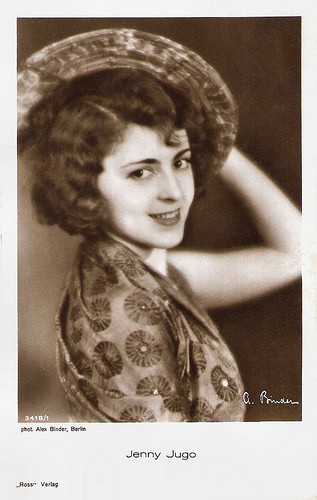
German postcard by Ross Verlag, no. 3418/1, 1928-1929. Photo: Alex Binder, Berlin.
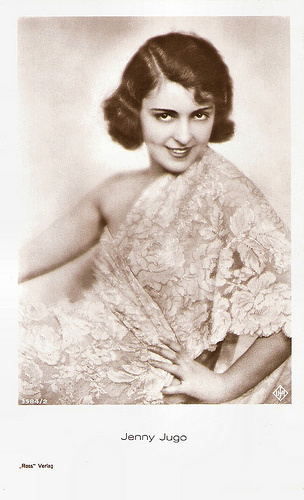
German postcard by Ross Verlag, no. 3584/2, 1928-1929. Photo: Ufa.
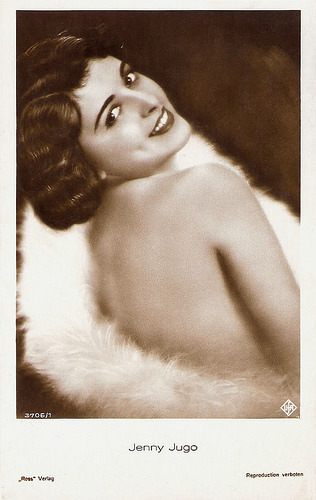
German postcard by Ross Verlag, no. 3706/1, 1928-1929. Photo: Ufa.
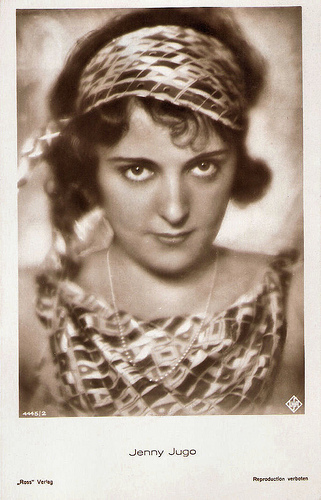
German postcard by Ross Verlag, no. 4445/2, 1929-1930. Photo: Ufa.
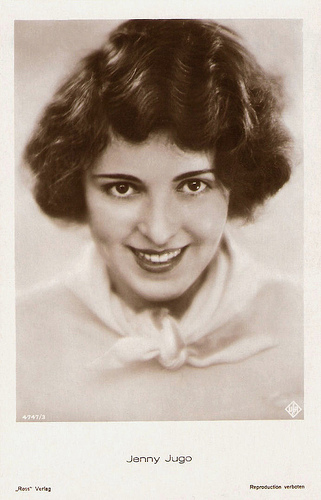
German postcard by Ross Verlag, no. 4747/3, 1929-1930. Photo: Ufa.
Talent For Comedy
Jenny Jugo was born as Eugenie Jenny Walter in Mürzzuschlag, Austria-Hungary (now Austria), in 1904, as the daughter of a factory owner. She grew up in Vienna and Graz, where she visited a monastic school.
At the age of 16 Jenny got married with the Italian actor Emo Jugo who took her to Berlin. Already one year later followed their separation. The famous producer Erich Pommer discovered Jenny for the cinema, and in 1924, she got a three-year contract from the Ufa.
She started to play in films like Die Puppe vom Lunapark/The Lunapark Doll (Jaap Speyer, 1925) with Adolphe Engers , Der Turm des Schweigens/The Tower of Silence (Johannes Guter, 1925), Die gefundene Braut/The Found Bride (Rochus Gliese, 1925) both starring Xenia Desni , Blitzzug der Liebe/Love Express Train (Johannes Guter, 1925) with Ossi Oswalda , and Liebe macht blind/Love Makes Us Blind (Lothar Mendes, 1925) with Georg Alexander .
Her dramatic roles were not very succesful and Ufa lent her to the Phoebus-Film A.G. There she made some of her most successful films like Schiff in Not/Ship Stranded (Fred Sauer, 1925) with Gustav Fröhlich , Casanova/The Loves of Casanova (Alexandre Volkoff, 1927) starring Ivan Mozzhukhin , and the Alexander Pushkin adaptation Pique Dame (Aleksandr Razumnyi, 1927).
As the vivacious and much younger wife of bureaucrat Werner Krauss she proved in the farce Die Hose/The Trousers (Hans Behrendt, 1927) her talent for comedy and self irony.
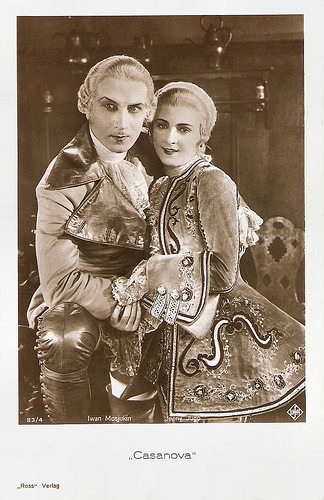
German postcard by Ross Verlag, no. 83/4. Photo: Ufa. Publicity still for Casanova (Alexandre Volkoff, 1927) with Ivan Mozzhukhin .
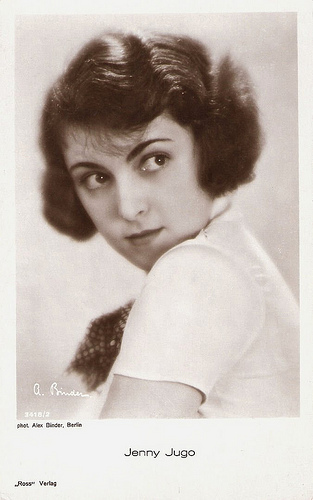
German postcard by Ross Verlag, no. 3418/2, 1928-1929. Photo: Alex Binder, Berlin.
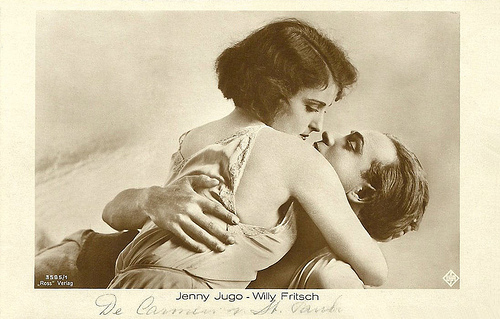
German postcard by Ross Verlag, no. 3585/1, 1928-1929. Photo: Ufa. Publicity still for Die Carmen von St. Pauli/The Carmen of St. Pauli (1928) with Willy Fritsch .
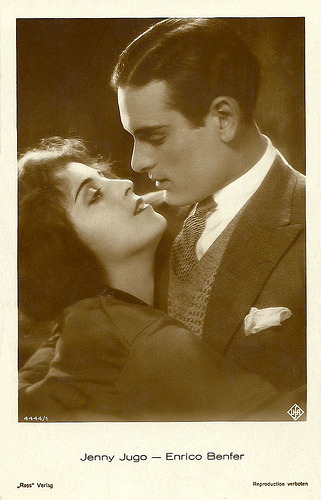
With Enrico Benfer . German postcard by Ross Verlag, no. 4444/1, 1929-1930. Photo: Ufa. Collection: Didier Hanson.
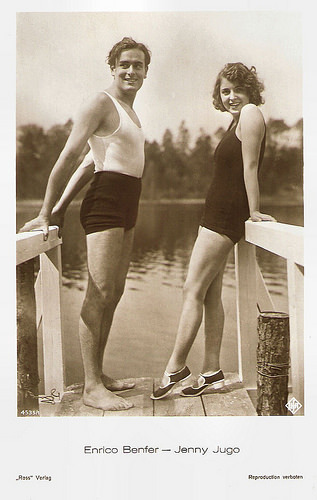
With Enrico Benfer . German postcard by Ross Verlag, no. 4535/1, 1929-1930. Photo: Ufa.
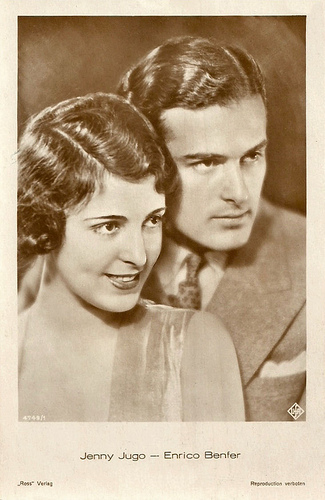
With Enrico Benfer . German postcard by Ross Verlag, no. 4749/1, 1929-1930. Photo: Ufa.
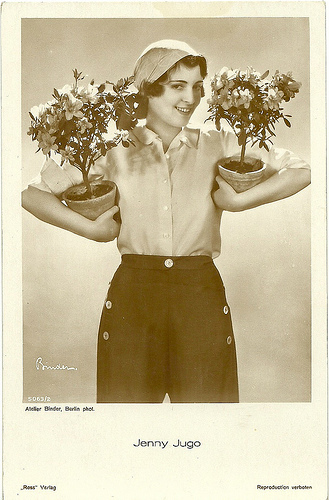
German postcard by Ross Verlag, no. 5063/2, 1930-1931. Photo: Alex Binder / Atelier Binder, Berlin. Collection: Didier Hanson.
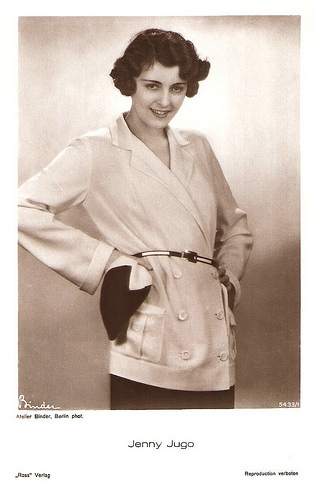
German postcard by Ross Verlag, no. 5433/2, 1930-1931. Photo: Atelier Binder, Berlin.
Just Naturalness
When the era of the silent film was over and sound film demanded a new acting talent and especially a very clear pronunciation, Jenny Jugo took acting lessons for the first time in her life. In the next years she acted in less important films like Kopfüber ins Glück/Headfirst in Happiness (Hans Steinhoff, 1929) with Fritz Schulz , and Die nackte Wahrheit/The Naked Truth (Karl Anton, 1931).
Starting with Wer nimmt die Liebe ernst?/Who Takes Love Seriously? (Erich Engel, 1931) starring Max Hansen, she began a cooperation with director Erich Engel who knew how to use her comedy talent. Till 1942 they shot eleven films together.
These included Fünf von der Jazzband/Five of the Jazzband (Erich Engel, 1932), the G.B. Shaw adaptation Pygmalion (Erich Engel, 1935) with Gustaf Gründgens, as the young Queen Victoria in Mädchenjahre einer Königin/Girlhood of a Queen (Erich Engel, 1936), Gefährliches Spiel/Dangerous Game (Erich Engel, 1937) opposite Harry Liedtke , Nanette (Erich Engel, 1939) with Hans Söhnker , and Viel Lärm um Nixi/Much Ado About Nixi (Erich Engel, 1942) with Albert Matterstock .
In these films she established an acting style which was described by Bertolt Brecht as "just naturalness". She belonged with Zarah Leander and Paula Wessely to the best-paid actresses of the Ufa.
However, she would play in only three more productions: Die Gattin/The Wife (Georg Jacoby, 1943), Träum' nicht, Anette/Don't Dream, Anette (Eberhard Klagemann, 1949) and Königskinder/Royal Children (Helmut Käutner, 1949) with Peter van Eyck .
In 1950 Jugo married actor Enrico Benfer a.k.a. Friedrich Benfer, with whom she had worked in many of her films. They retired from the film business to a farm in Schönrain near Bad Heilbrunn, Bavaria. In 1971 she was awarded the Filmband in Gold for her long and outstanding contributions to the German cinema. In the 1970s a medical treatment went wrong, and since then Jugo was tied up to a wheelchair.
Jenny Jugo died in 2001 in Schwaighofen near Königsdorf, Germany. She was 96. In the summer of 2006, the film museum of Potsdam acquired a quite special collection: about forty costumes which Jugo had worn in her Ufa films and numerous documents, which the star herself had saved at her High-Bavarian farm.
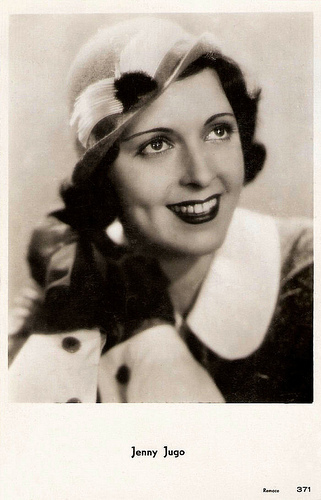
Dutch postcard by JosPe, no. 371. Photo: Remaco.

German postcard by Ross Verlag, no. 6156/3, 1931-1932. Photo: Atelier Binder, Berlin.
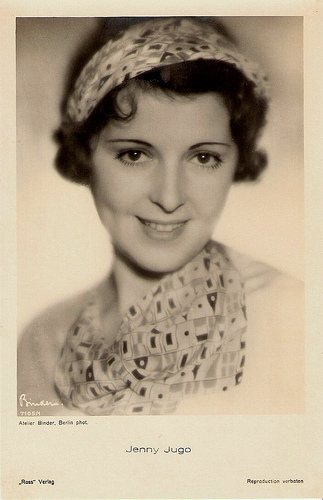
German postcard by Ross Verlag, no. 7105/1, 1932-1933. Photo: Alex Binder / Atelier Binder, Berlin.
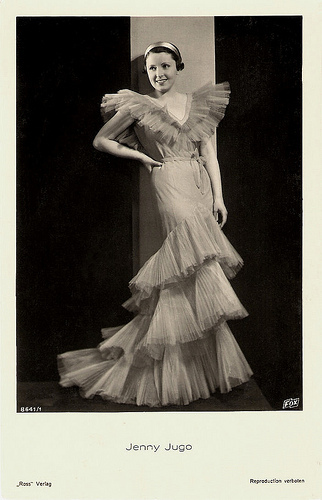
German postcard by Ross Verlag, no. 8641/1, 1933-1934. Photo: Fox. Publicity still for ...heute abend bei mir/Tonight with me (Carl Boese, 1934).
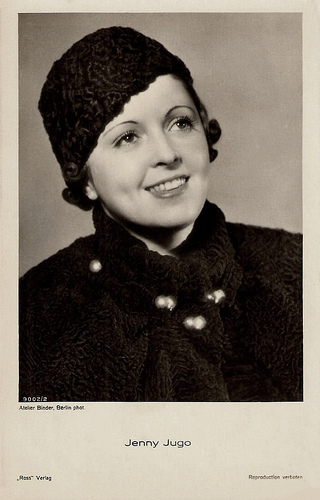
German postcard by Ross Verlag, no. 9007/2, 1934-1935. Photo: Atelier Binder, Berlin.
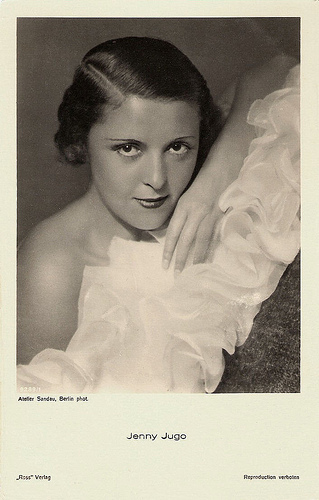
German postcard by Ross Verlag, no. 9289/1, 1935-1936. Photo: Atelier Sandau, Berlin.
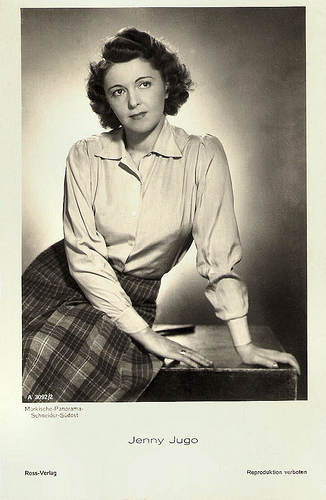
German postcard by Ross Verlag, no. A 3092/2, 1941-1944. Photo: Markische-Panorama-Schneider-Südost.
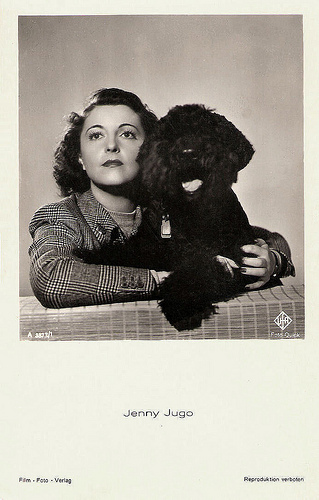
German postcard by Film-Foto-Verlag, no. A 3873/1, 1941-1944. Photo: Quick / Ufa.
Sources: Stephanie D'heil (Steffi-line - German), Thomas Staedeli (Cyranos), Filmportal.de, and Wikipedia (German).

German postcard by Ross Verlag, no. 3418/1, 1928-1929. Photo: Alex Binder, Berlin.

German postcard by Ross Verlag, no. 3584/2, 1928-1929. Photo: Ufa.

German postcard by Ross Verlag, no. 3706/1, 1928-1929. Photo: Ufa.

German postcard by Ross Verlag, no. 4445/2, 1929-1930. Photo: Ufa.

German postcard by Ross Verlag, no. 4747/3, 1929-1930. Photo: Ufa.
Talent For Comedy
Jenny Jugo was born as Eugenie Jenny Walter in Mürzzuschlag, Austria-Hungary (now Austria), in 1904, as the daughter of a factory owner. She grew up in Vienna and Graz, where she visited a monastic school.
At the age of 16 Jenny got married with the Italian actor Emo Jugo who took her to Berlin. Already one year later followed their separation. The famous producer Erich Pommer discovered Jenny for the cinema, and in 1924, she got a three-year contract from the Ufa.
She started to play in films like Die Puppe vom Lunapark/The Lunapark Doll (Jaap Speyer, 1925) with Adolphe Engers , Der Turm des Schweigens/The Tower of Silence (Johannes Guter, 1925), Die gefundene Braut/The Found Bride (Rochus Gliese, 1925) both starring Xenia Desni , Blitzzug der Liebe/Love Express Train (Johannes Guter, 1925) with Ossi Oswalda , and Liebe macht blind/Love Makes Us Blind (Lothar Mendes, 1925) with Georg Alexander .
Her dramatic roles were not very succesful and Ufa lent her to the Phoebus-Film A.G. There she made some of her most successful films like Schiff in Not/Ship Stranded (Fred Sauer, 1925) with Gustav Fröhlich , Casanova/The Loves of Casanova (Alexandre Volkoff, 1927) starring Ivan Mozzhukhin , and the Alexander Pushkin adaptation Pique Dame (Aleksandr Razumnyi, 1927).
As the vivacious and much younger wife of bureaucrat Werner Krauss she proved in the farce Die Hose/The Trousers (Hans Behrendt, 1927) her talent for comedy and self irony.

German postcard by Ross Verlag, no. 83/4. Photo: Ufa. Publicity still for Casanova (Alexandre Volkoff, 1927) with Ivan Mozzhukhin .

German postcard by Ross Verlag, no. 3418/2, 1928-1929. Photo: Alex Binder, Berlin.

German postcard by Ross Verlag, no. 3585/1, 1928-1929. Photo: Ufa. Publicity still for Die Carmen von St. Pauli/The Carmen of St. Pauli (1928) with Willy Fritsch .

With Enrico Benfer . German postcard by Ross Verlag, no. 4444/1, 1929-1930. Photo: Ufa. Collection: Didier Hanson.

With Enrico Benfer . German postcard by Ross Verlag, no. 4535/1, 1929-1930. Photo: Ufa.

With Enrico Benfer . German postcard by Ross Verlag, no. 4749/1, 1929-1930. Photo: Ufa.

German postcard by Ross Verlag, no. 5063/2, 1930-1931. Photo: Alex Binder / Atelier Binder, Berlin. Collection: Didier Hanson.

German postcard by Ross Verlag, no. 5433/2, 1930-1931. Photo: Atelier Binder, Berlin.
Just Naturalness
When the era of the silent film was over and sound film demanded a new acting talent and especially a very clear pronunciation, Jenny Jugo took acting lessons for the first time in her life. In the next years she acted in less important films like Kopfüber ins Glück/Headfirst in Happiness (Hans Steinhoff, 1929) with Fritz Schulz , and Die nackte Wahrheit/The Naked Truth (Karl Anton, 1931).
Starting with Wer nimmt die Liebe ernst?/Who Takes Love Seriously? (Erich Engel, 1931) starring Max Hansen, she began a cooperation with director Erich Engel who knew how to use her comedy talent. Till 1942 they shot eleven films together.
These included Fünf von der Jazzband/Five of the Jazzband (Erich Engel, 1932), the G.B. Shaw adaptation Pygmalion (Erich Engel, 1935) with Gustaf Gründgens, as the young Queen Victoria in Mädchenjahre einer Königin/Girlhood of a Queen (Erich Engel, 1936), Gefährliches Spiel/Dangerous Game (Erich Engel, 1937) opposite Harry Liedtke , Nanette (Erich Engel, 1939) with Hans Söhnker , and Viel Lärm um Nixi/Much Ado About Nixi (Erich Engel, 1942) with Albert Matterstock .
In these films she established an acting style which was described by Bertolt Brecht as "just naturalness". She belonged with Zarah Leander and Paula Wessely to the best-paid actresses of the Ufa.
However, she would play in only three more productions: Die Gattin/The Wife (Georg Jacoby, 1943), Träum' nicht, Anette/Don't Dream, Anette (Eberhard Klagemann, 1949) and Königskinder/Royal Children (Helmut Käutner, 1949) with Peter van Eyck .
In 1950 Jugo married actor Enrico Benfer a.k.a. Friedrich Benfer, with whom she had worked in many of her films. They retired from the film business to a farm in Schönrain near Bad Heilbrunn, Bavaria. In 1971 she was awarded the Filmband in Gold for her long and outstanding contributions to the German cinema. In the 1970s a medical treatment went wrong, and since then Jugo was tied up to a wheelchair.
Jenny Jugo died in 2001 in Schwaighofen near Königsdorf, Germany. She was 96. In the summer of 2006, the film museum of Potsdam acquired a quite special collection: about forty costumes which Jugo had worn in her Ufa films and numerous documents, which the star herself had saved at her High-Bavarian farm.

Dutch postcard by JosPe, no. 371. Photo: Remaco.

German postcard by Ross Verlag, no. 6156/3, 1931-1932. Photo: Atelier Binder, Berlin.

German postcard by Ross Verlag, no. 7105/1, 1932-1933. Photo: Alex Binder / Atelier Binder, Berlin.

German postcard by Ross Verlag, no. 8641/1, 1933-1934. Photo: Fox. Publicity still for ...heute abend bei mir/Tonight with me (Carl Boese, 1934).

German postcard by Ross Verlag, no. 9007/2, 1934-1935. Photo: Atelier Binder, Berlin.

German postcard by Ross Verlag, no. 9289/1, 1935-1936. Photo: Atelier Sandau, Berlin.

German postcard by Ross Verlag, no. A 3092/2, 1941-1944. Photo: Markische-Panorama-Schneider-Südost.

German postcard by Film-Foto-Verlag, no. A 3873/1, 1941-1944. Photo: Quick / Ufa.
Sources: Stephanie D'heil (Steffi-line - German), Thomas Staedeli (Cyranos), Filmportal.de, and Wikipedia (German).
Published on March 12, 2016 22:00
March 11, 2016
Rudi Carrell
It's Boekenweek, the national Book Week in the Netherlands. Today, Die van Carrell is presented, a new, Dutch biography on television show master, actor and singer Rudi Carrell (1934-2006), written by his daughter Caroline Kesselaar. After his breakthrough in the Dutch show business, Carrell went to Germany where he gained enormous popularity on television. He was the first presenter to attract a TV audience of 20 million Germans, one quarter of the total population. He also acted in several German films. Nowadays, Carrell is seen as one of the greatest TV entertainers in Europe. The well-written memoir by his youngest daughter presents an interesting, intimate view of her talented, humorous but often unreachable father. Several postcards from this EFSP post are used for a small exhibition around the book in Athenaeum Boekhandel, Amsterdam's most prominent bookshop.
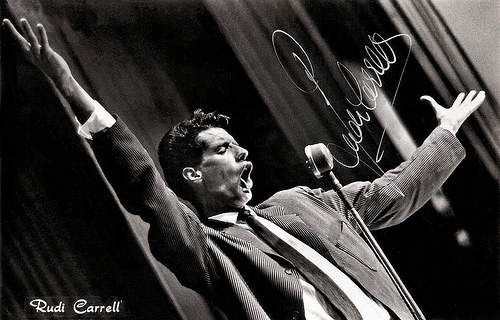
Dutch postcard.
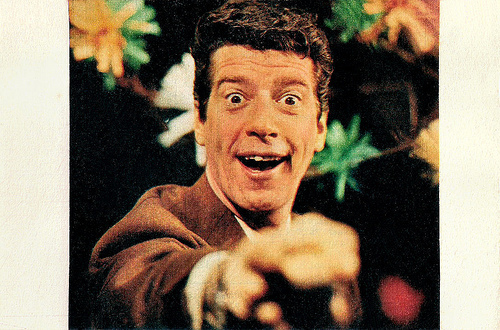
Dutch postcard.
Entertainer, Magician and Ventriloquist
Rudi Carrell was born as Rudolf Wijbrand Kesselaar in Alkmaar, the Dutch cheese capital, in 1934. He was the eldest of four children of Andries Kesselaar and his wife Catharina Houtkooper.
His father was an entertainer with the stage name André Carrell, his grandfather was a comic. By the time Rudi was 17, he was an accomplished magician and ventriloquist. In 1953 Rudi was deputising for his father when André had double booked himself.
Rudi made an effortless transition from stage to studio and in 1959 he hosted his own TV show, the Rudi Carrell Show. In 1960 he represented the Netherlands at the Eurovision Song Contest with the song Wat een geluk/How Lucky and finished 12th out of 13 scoring just 2 points.
He had more luck as a show master. In 1963 he won the Nipkov Award of the Dutch TV critics and in 1964 an episode of the Rudi Carrell Show won the prestigious Silver Rose at the Montreux Television Festival. This episode was shot on an artificial, uninhabited island, where Robinson Crusoe (Carrell) and his monkey Friday get a visit from a mermaid, played by singer Esther Ofarim.
The success of the show led him to Germany in 1965, where he would host the Rudi Carrell Show and many other shows until 2002. His work ranged from game shows, through comedy, variety, and current affairs. His timing and his perfect mastery of the script made him the darling of German audiences. His show was also pretty popular in some other European non-German speaking countries like Slovenia.
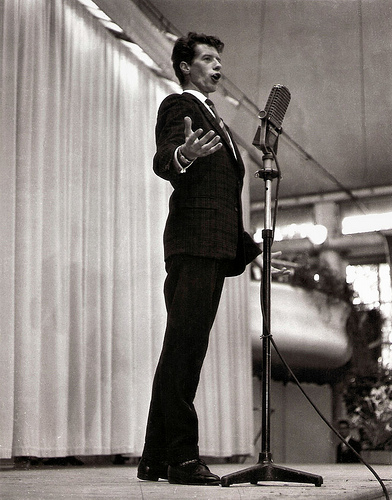
Dutch postcard.
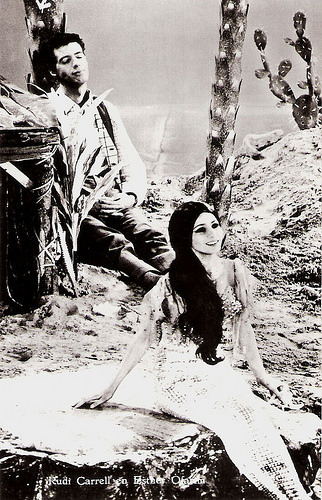
Dutch postcard by Int. Filmpers, Amsterdam, no. 1178. Photo: Phonogram. Still from the episode of the Rudi Carrell Show which won the Silver Rose award of the Montreux television festival 1964. Carrell as Robinson Crusoe who gets a visit from mermaid Esther Ofarim.
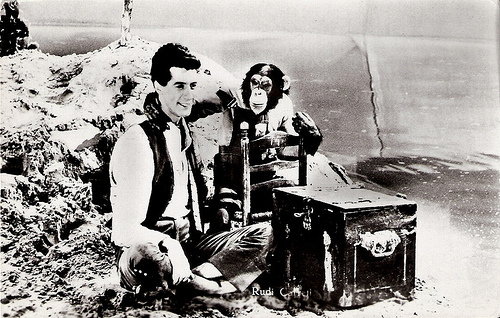
Dutch postcard by Phonogram / Gebr. Spanjersberg N.V., Rotterdam (SPARO), no. 1210. Photo: still from the episode of the Rudi Carrell Show that won the prestigious Silver Rose of the Montreux Television Festival 1964. Robinson Crusoe (Carrell) and his monkey Friday.
Cross-dressing Farces
Rudi Carrell acted in several German films. He was the lead in a series of cross-dressing farces: Wenn die tollen Tanten kommen/When the Mad Aunts Are Coming (Franz Josef Gottlieb, 1970) with Ilja Richter, Tante Trude aus Buxtehude/Aunt Trude From Buxtehude (Franz Josef Gottlieb, 1971) with Theo Lingen , and Die Tollen Tanten schlagen zu/The Mad Aunts Strike Out (Franz Josef Gottlieb, 1971).
Other slapstick comedies were Rudi, benimm dich/Behave, Rudi (Franz Josef Gottlieb, 1971) with Chris Roberts, Hochwürden drückt ein Auge zu/Reverend Closes an Eye (Harald Vock, 1971) starring Schlager singer Roy Black , and Crazy - total verrückt/Crazy - Completely Mad (Franz Josef Gottlieb, 1973) opposite former teen idol Cornelia - Conny - Froboess .
In those film comedies he was called ‘Der Rudi’, as he was in real life referred to in every pub and café.
The comedies attracted good audiences, but after 1973 Carrell only incidentally made a film, such as Starke Zeiten/Heavy Times (Rolf Olsen a.o., 1988).
He was also a pop singer with a number of hits. Wann wird`s mal wieder richtig Sommer?/When Will It Be A Real Summer Again? became a big hit in 1975. It was based on the American hit song City of New Orleans by Steve Goodman and made famous by Arlo Guthrie.
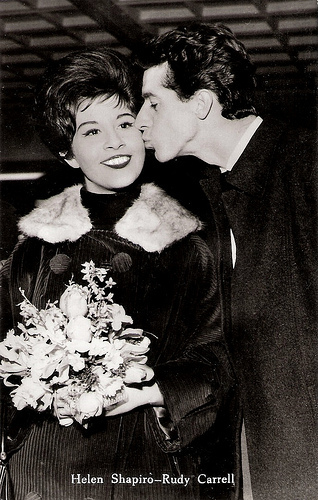
With Helen Shapiro . Dutch postcard by Sparo (Gebr. Spanjersberg N.V., Rotterdam). Sent by mail in the Netherlands in 1966. Photo: Columbia.
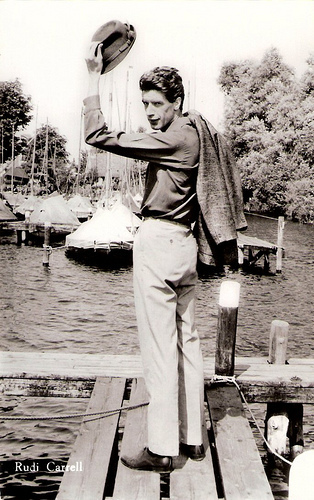
Dutch postcard by Hercules, Haarlem, no. 852.
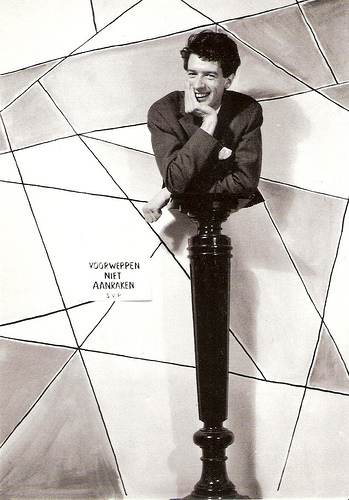
Dutch postcard by Art Unlimited, Amsterdam, no. B 1753, 1993. Photo: Dirk de Herder, 1962.
Outrage
A sketch on Rudi’s Tagesshow/Rudi's Daily Show (1984) provoked a serious diplomatic incident with Iran. A crowd of women threw bras and knickers at a mock-up of the Ayatollah Khomeini, at that time Iran’s spiritual as well as lay leader. The outrage in Tehran brought thousands on to the streets, led to the expulsion of two German diplomats, the closure of the Iranian consulates in Berlin, Hamburg and Frankfurt, the cancellation of flights between Bonn, then the West German capital, and Tehran.
An intervention from the then Dutch Foreign Minister stopped the scene being repeated on Dutch television. Carrell came under threat from fundamentalists, until he officially apologized in 1987.
He received many awards in the Netherlands and Germany, amongst others the Bundesverdienstkreuz (the only award given by the Federal Republic of Germany, for extraordinary achievements in politics or culture) in 1985.
Although living and working in Germany for 40 years he always spoke with a heavy Dutch accent. He smoked 60 cigarettes a day, and in 2005 he had lung cancer diagnosed. In a farewell TV appearance in 2006 he was presented with Germany’s highest TV award, the Golden Camera. He also received the Bundesverdienstkreuz, Germany's Cross of Merit, for his achievements in German-Dutch relations in 1985, and he was given the Honorary Rose at the Festival of Montreux for his lifetime achievements in 2001.
Rudi Carrell died in 2006 in Bremen, Germany. He was 71. He had been married three times. His wives were Truus de Vries (1957-1973) with whom he had two children, Annemieke and Caroline; Anke Bobbert (1974-2000) with whom he had a son, Alexander; and Simone Felischak (2002-2006). Caroline's book Die van Carrell will be presented today in Boekhandel feijn in Rudi Carrell's birthplace Alkmaar.
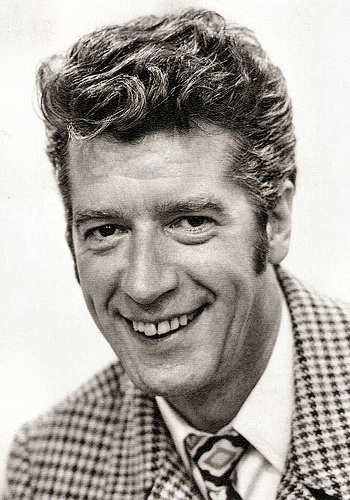
German card by Süddeutscher Rundfunk, Stuttgart. Photo: Hugo Jehle.
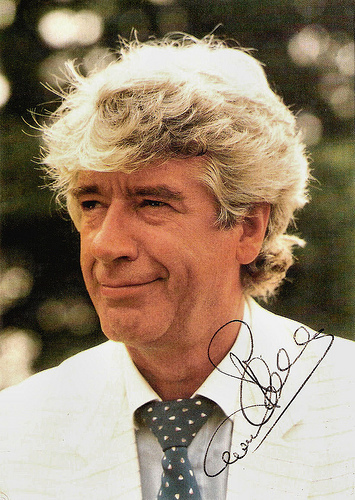
German postcard by Westdeutschen Rundfunk, Köln. Photo: R. Rutgers.
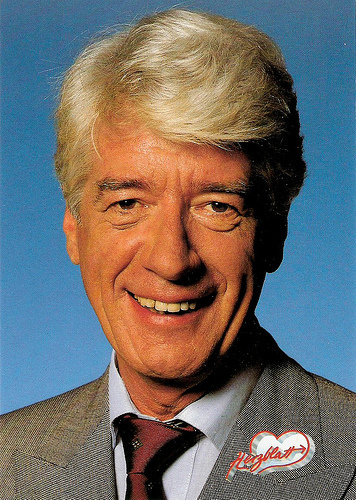
German postcard by Thomas Klinger, München. Photo: Bayerischer Rundfunk.
Rudi Carrell sings the song Wat een geluk/How Lucky at the 1960 Eurovision Song Contest. Source: huelezelf (YouTube).
Sources: Times Online, Wikipedia, Birth Television Archive and .

Dutch postcard.

Dutch postcard.
Entertainer, Magician and Ventriloquist
Rudi Carrell was born as Rudolf Wijbrand Kesselaar in Alkmaar, the Dutch cheese capital, in 1934. He was the eldest of four children of Andries Kesselaar and his wife Catharina Houtkooper.
His father was an entertainer with the stage name André Carrell, his grandfather was a comic. By the time Rudi was 17, he was an accomplished magician and ventriloquist. In 1953 Rudi was deputising for his father when André had double booked himself.
Rudi made an effortless transition from stage to studio and in 1959 he hosted his own TV show, the Rudi Carrell Show. In 1960 he represented the Netherlands at the Eurovision Song Contest with the song Wat een geluk/How Lucky and finished 12th out of 13 scoring just 2 points.
He had more luck as a show master. In 1963 he won the Nipkov Award of the Dutch TV critics and in 1964 an episode of the Rudi Carrell Show won the prestigious Silver Rose at the Montreux Television Festival. This episode was shot on an artificial, uninhabited island, where Robinson Crusoe (Carrell) and his monkey Friday get a visit from a mermaid, played by singer Esther Ofarim.
The success of the show led him to Germany in 1965, where he would host the Rudi Carrell Show and many other shows until 2002. His work ranged from game shows, through comedy, variety, and current affairs. His timing and his perfect mastery of the script made him the darling of German audiences. His show was also pretty popular in some other European non-German speaking countries like Slovenia.

Dutch postcard.

Dutch postcard by Int. Filmpers, Amsterdam, no. 1178. Photo: Phonogram. Still from the episode of the Rudi Carrell Show which won the Silver Rose award of the Montreux television festival 1964. Carrell as Robinson Crusoe who gets a visit from mermaid Esther Ofarim.

Dutch postcard by Phonogram / Gebr. Spanjersberg N.V., Rotterdam (SPARO), no. 1210. Photo: still from the episode of the Rudi Carrell Show that won the prestigious Silver Rose of the Montreux Television Festival 1964. Robinson Crusoe (Carrell) and his monkey Friday.
Cross-dressing Farces
Rudi Carrell acted in several German films. He was the lead in a series of cross-dressing farces: Wenn die tollen Tanten kommen/When the Mad Aunts Are Coming (Franz Josef Gottlieb, 1970) with Ilja Richter, Tante Trude aus Buxtehude/Aunt Trude From Buxtehude (Franz Josef Gottlieb, 1971) with Theo Lingen , and Die Tollen Tanten schlagen zu/The Mad Aunts Strike Out (Franz Josef Gottlieb, 1971).
Other slapstick comedies were Rudi, benimm dich/Behave, Rudi (Franz Josef Gottlieb, 1971) with Chris Roberts, Hochwürden drückt ein Auge zu/Reverend Closes an Eye (Harald Vock, 1971) starring Schlager singer Roy Black , and Crazy - total verrückt/Crazy - Completely Mad (Franz Josef Gottlieb, 1973) opposite former teen idol Cornelia - Conny - Froboess .
In those film comedies he was called ‘Der Rudi’, as he was in real life referred to in every pub and café.
The comedies attracted good audiences, but after 1973 Carrell only incidentally made a film, such as Starke Zeiten/Heavy Times (Rolf Olsen a.o., 1988).
He was also a pop singer with a number of hits. Wann wird`s mal wieder richtig Sommer?/When Will It Be A Real Summer Again? became a big hit in 1975. It was based on the American hit song City of New Orleans by Steve Goodman and made famous by Arlo Guthrie.

With Helen Shapiro . Dutch postcard by Sparo (Gebr. Spanjersberg N.V., Rotterdam). Sent by mail in the Netherlands in 1966. Photo: Columbia.

Dutch postcard by Hercules, Haarlem, no. 852.

Dutch postcard by Art Unlimited, Amsterdam, no. B 1753, 1993. Photo: Dirk de Herder, 1962.
Outrage
A sketch on Rudi’s Tagesshow/Rudi's Daily Show (1984) provoked a serious diplomatic incident with Iran. A crowd of women threw bras and knickers at a mock-up of the Ayatollah Khomeini, at that time Iran’s spiritual as well as lay leader. The outrage in Tehran brought thousands on to the streets, led to the expulsion of two German diplomats, the closure of the Iranian consulates in Berlin, Hamburg and Frankfurt, the cancellation of flights between Bonn, then the West German capital, and Tehran.
An intervention from the then Dutch Foreign Minister stopped the scene being repeated on Dutch television. Carrell came under threat from fundamentalists, until he officially apologized in 1987.
He received many awards in the Netherlands and Germany, amongst others the Bundesverdienstkreuz (the only award given by the Federal Republic of Germany, for extraordinary achievements in politics or culture) in 1985.
Although living and working in Germany for 40 years he always spoke with a heavy Dutch accent. He smoked 60 cigarettes a day, and in 2005 he had lung cancer diagnosed. In a farewell TV appearance in 2006 he was presented with Germany’s highest TV award, the Golden Camera. He also received the Bundesverdienstkreuz, Germany's Cross of Merit, for his achievements in German-Dutch relations in 1985, and he was given the Honorary Rose at the Festival of Montreux for his lifetime achievements in 2001.
Rudi Carrell died in 2006 in Bremen, Germany. He was 71. He had been married three times. His wives were Truus de Vries (1957-1973) with whom he had two children, Annemieke and Caroline; Anke Bobbert (1974-2000) with whom he had a son, Alexander; and Simone Felischak (2002-2006). Caroline's book Die van Carrell will be presented today in Boekhandel feijn in Rudi Carrell's birthplace Alkmaar.

German card by Süddeutscher Rundfunk, Stuttgart. Photo: Hugo Jehle.

German postcard by Westdeutschen Rundfunk, Köln. Photo: R. Rutgers.

German postcard by Thomas Klinger, München. Photo: Bayerischer Rundfunk.
Rudi Carrell sings the song Wat een geluk/How Lucky at the 1960 Eurovision Song Contest. Source: huelezelf (YouTube).
Sources: Times Online, Wikipedia, Birth Television Archive and .
Published on March 11, 2016 22:00
March 10, 2016
EFSP's Dazzling Dozen: A hundred years ago
Here are twelve new and rare acquisitions from the collection of our friend Didier Hanson. Didier has lots of postcards from the Russian Empire, both of the stage reformers and of early Russian film stars. He keeps amazing me. Here are twelve dazzling cards, produced in the year 1916 or around that time. The silent cinema of the Russian Empire was at its peak. Just a few years later most of these talents had left Russia and were working in Berlin or Paris, or were dead.
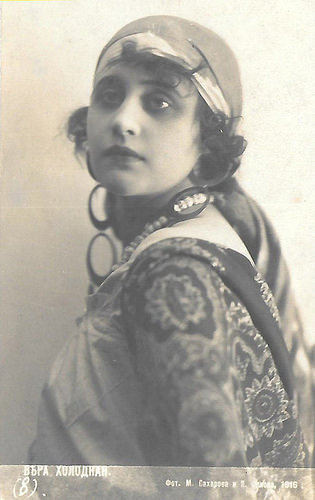
Vera Kholodnaya. Russian postcard, no. 8. Photo: M. Saharova, 1916. Collection: Didier Hanson.
Vera Kholodnaya (1893-1919) was the first star of the Russian silent cinema. Only 26, the ‘Queen of Screen’ died of the Spanish flu during the pandemic of 1919. Although she worked only three years for the cinema, she must have made between fifty and hundred short films. The Soviet authorities ordered to destroy many of the Kholodnaya features in 1924, and only five of her films still exist.
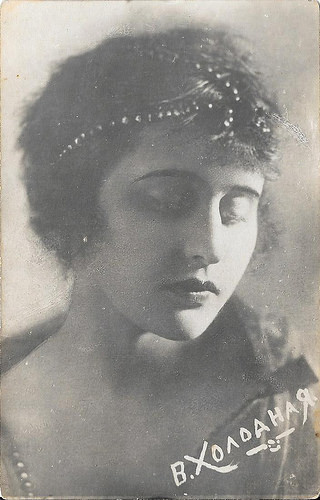
Vera Kholodnaya. Russian postcard. Collection: Didier Hanson.
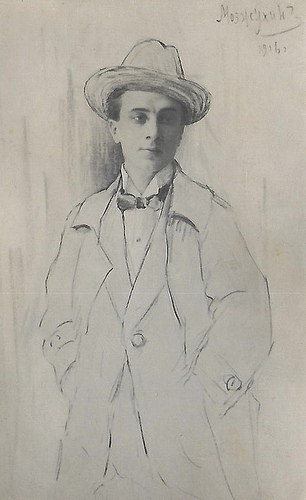
Ivan Mozzhukhin. Russian postcard, 1916. Collection: Didier Hanson.
Russian actor Ivan Mozzhukhin (1889-1939) was a legendary star of the European silent film, who shone in Russia, France, Germany and Austria, but suffered in Hollywood.
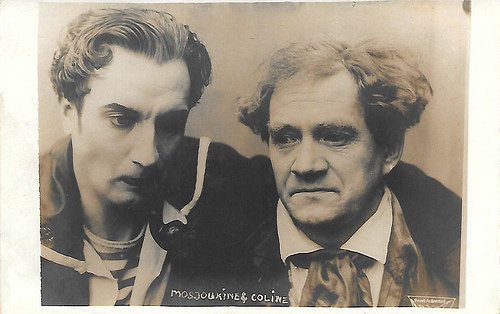
Ivan Mozzhukhin and Nicolas Koline. Vintage postcard. Collection: Didier Hanson.
Nicolas Koline (1978-1966) was a Russian actor who began his career in Russia, worked in the French cinema with other Russian emigres and finished his film career in Germany.
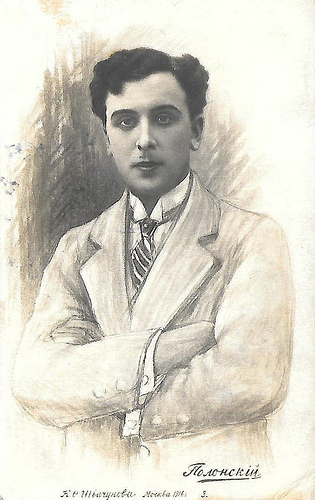
Vitold Polonsky. Russian postcard, Moscow, 1916, no. 3. Collection: Didier Hanson.
Vitold Polonsky (1879-1919) was one of the most popular actors in pre-Revolutionary Russian cinema.
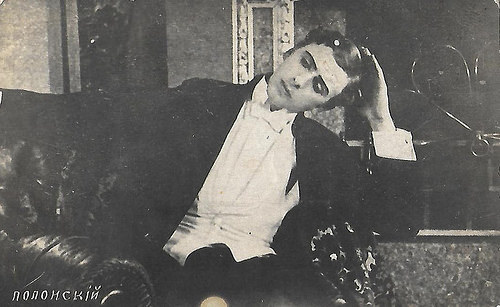
Vitold Polonsky. Russian postcard. Collection: Didier Hanson.
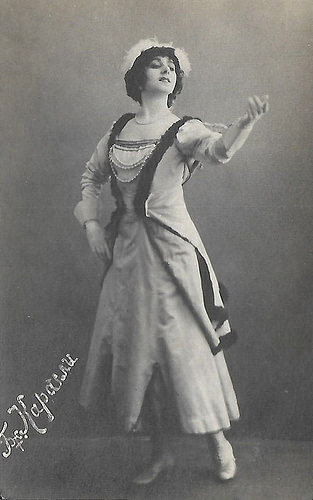
Vera Karalli. Russian postcard. Collection: Didier Hanson.
Vera Karalli (1889-1972) was a Russian ballet dancer, choreographer and actress in the early 20th century.
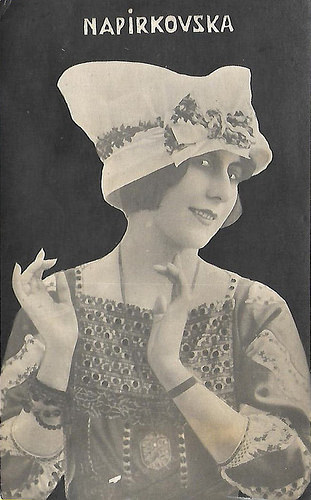
Stacia Napierkowska. Russian postcard. Collection: Didier Hanson.
Exotic Stacia Napierkowska (1886-1945) was a fascinating star of the silent film era. The French actress and dancer is best remembered as the seductive but cruel Queen Antinéa in the classic fantasy L’Atlantide/Missing Husbands (1921). Between 1908 and 1926 she appeared in 86 films.
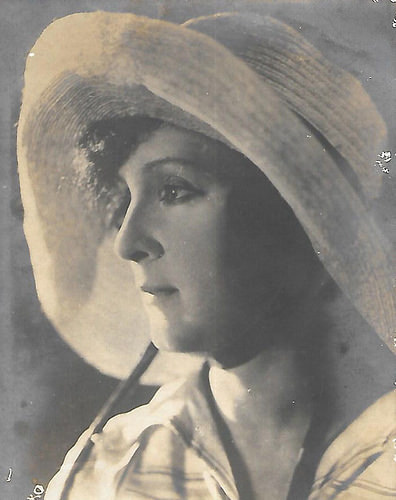
Nathalie Lissenko. Russian postcard. Collection: Didier Hanson.
Nathalie Lissenko (1884/1886-1969), aka Natalya Lyssenko, Natalie Lissenko, and Natal’ya Lisenko, is most famous for the French silent films of the 1920s, in which is she was often paired with her husband Ivan Mozzhukhin .
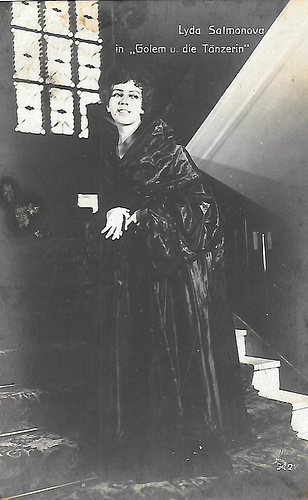
Lyda Salmonova. German postcard, no. 942. Photo: publicity still for Der Golem und die Tänzerin/The Golem and the Dancing Girl (Rochus Gliese, Paul Wegener, 1917). Collection: Didier Hanson.
Czech stage and film actress Lyda Salmonova (1889–1968) was married to German actor Paul Wegener and appeared with him in silent horror classics like Der Student von Prag/The Student of Prague (1913) and Der Golem (1915 and 1920).
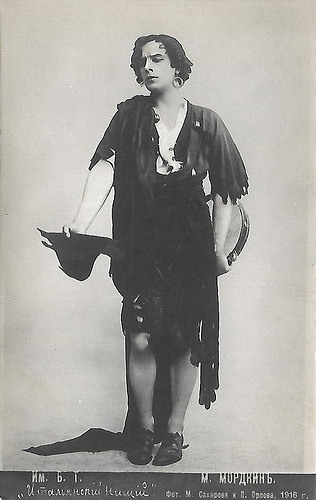
Mikhail Mordkin. Russian postcard. Photo: M. Saharova, L. Orlova, 1916. Collection: Didier Hanson.
Handsome Mikhail Mordkin (1880-1944) was a famous Russian ballet dancer. He started at the Bolshoi Ballet, joined Diaghilev's ballet in 1909, and in 1924, he settled in the United States, where he founded the Mordkin Ballet, and helped to build the foundation for ballet in America. He also appeared in one Russian film, Aziade (1918).
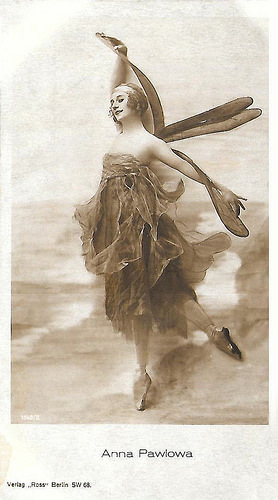
Anna Pavlova. German postcard by Ross Verlag, Berlin, no. 1540/2, 1927-1928. Collection: Didier Hanson.
Anna Pavlova (Russian: Анна Павлова; 1881–1931) was a Russian prima ballerina of the late 19th and the early 20th centuries. She was a principal artist of the Imperial Russian Ballet and the Ballets Russes of Sergei Diaghilev. Pavlova is most recognised for the creation of the role The Dying Swan and, with her own company, became the first ballerina to tour ballet around the world.
Thanks, Didier! This is a post for Postcard Friendship Friday, hosted by Beth at the The Best Hearts are Crunchy. You can visit her by clicking on the button below.


Vera Kholodnaya. Russian postcard, no. 8. Photo: M. Saharova, 1916. Collection: Didier Hanson.
Vera Kholodnaya (1893-1919) was the first star of the Russian silent cinema. Only 26, the ‘Queen of Screen’ died of the Spanish flu during the pandemic of 1919. Although she worked only three years for the cinema, she must have made between fifty and hundred short films. The Soviet authorities ordered to destroy many of the Kholodnaya features in 1924, and only five of her films still exist.

Vera Kholodnaya. Russian postcard. Collection: Didier Hanson.

Ivan Mozzhukhin. Russian postcard, 1916. Collection: Didier Hanson.
Russian actor Ivan Mozzhukhin (1889-1939) was a legendary star of the European silent film, who shone in Russia, France, Germany and Austria, but suffered in Hollywood.

Ivan Mozzhukhin and Nicolas Koline. Vintage postcard. Collection: Didier Hanson.
Nicolas Koline (1978-1966) was a Russian actor who began his career in Russia, worked in the French cinema with other Russian emigres and finished his film career in Germany.

Vitold Polonsky. Russian postcard, Moscow, 1916, no. 3. Collection: Didier Hanson.
Vitold Polonsky (1879-1919) was one of the most popular actors in pre-Revolutionary Russian cinema.

Vitold Polonsky. Russian postcard. Collection: Didier Hanson.

Vera Karalli. Russian postcard. Collection: Didier Hanson.
Vera Karalli (1889-1972) was a Russian ballet dancer, choreographer and actress in the early 20th century.

Stacia Napierkowska. Russian postcard. Collection: Didier Hanson.
Exotic Stacia Napierkowska (1886-1945) was a fascinating star of the silent film era. The French actress and dancer is best remembered as the seductive but cruel Queen Antinéa in the classic fantasy L’Atlantide/Missing Husbands (1921). Between 1908 and 1926 she appeared in 86 films.

Nathalie Lissenko. Russian postcard. Collection: Didier Hanson.
Nathalie Lissenko (1884/1886-1969), aka Natalya Lyssenko, Natalie Lissenko, and Natal’ya Lisenko, is most famous for the French silent films of the 1920s, in which is she was often paired with her husband Ivan Mozzhukhin .

Lyda Salmonova. German postcard, no. 942. Photo: publicity still for Der Golem und die Tänzerin/The Golem and the Dancing Girl (Rochus Gliese, Paul Wegener, 1917). Collection: Didier Hanson.
Czech stage and film actress Lyda Salmonova (1889–1968) was married to German actor Paul Wegener and appeared with him in silent horror classics like Der Student von Prag/The Student of Prague (1913) and Der Golem (1915 and 1920).

Mikhail Mordkin. Russian postcard. Photo: M. Saharova, L. Orlova, 1916. Collection: Didier Hanson.
Handsome Mikhail Mordkin (1880-1944) was a famous Russian ballet dancer. He started at the Bolshoi Ballet, joined Diaghilev's ballet in 1909, and in 1924, he settled in the United States, where he founded the Mordkin Ballet, and helped to build the foundation for ballet in America. He also appeared in one Russian film, Aziade (1918).

Anna Pavlova. German postcard by Ross Verlag, Berlin, no. 1540/2, 1927-1928. Collection: Didier Hanson.
Anna Pavlova (Russian: Анна Павлова; 1881–1931) was a Russian prima ballerina of the late 19th and the early 20th centuries. She was a principal artist of the Imperial Russian Ballet and the Ballets Russes of Sergei Diaghilev. Pavlova is most recognised for the creation of the role The Dying Swan and, with her own company, became the first ballerina to tour ballet around the world.
Thanks, Didier! This is a post for Postcard Friendship Friday, hosted by Beth at the The Best Hearts are Crunchy. You can visit her by clicking on the button below.

Published on March 10, 2016 22:00
March 9, 2016
Camillo Pilotto
Italian stage and screen actor Camillo Pilotto (1888-1963) started his film career in the early silent cinema, but only became a star after sound film was introduced. During the fascist regime of Benito Mussolini he was popular through the Telefoni Bianchi films, the sophisticated Italian comedies of the 1930s, but he also starred in such historical epics as Scipione l’Africano (1937) and Abuna Messias/Cardinal Messias (1939).
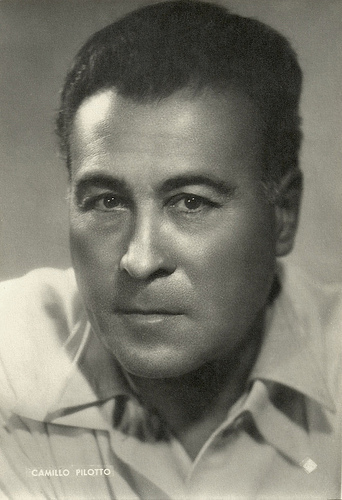
Italian postcard by Agency Aser, no. 92. Photo: Ciolfi.
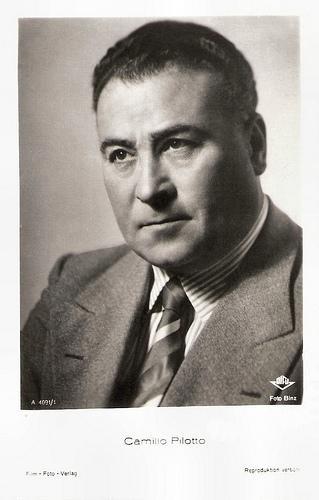
German postcard by Film-Foto-Verlag, no. A 4091/1, 1941-1944. Photo: Binz / Difu.
Personally Attached to Pirandello
Camillo Pilotto was born in Roma (Rome) in 1888 (according to Wikipedia ; IMDb mentions 1890). He was the son of actor and stagewriter Libero Pilotto.
In 1903, at the age of 15, he started to perform on stage with the company of Ermete Novelli and continued to perform with the most renowned theatre companies until the late 1950s.
Remarkable in the postwar era was his part of Cotrone in Luigi Pirandello’s I giganti della montagna, directed by Giorgio Strehler. Pilotto was personally attached to Pirandello.
Pilotto’s film debut happened in 1916 in Il sopravissuto (Augusto Genina, 1916) after which a handful of silent films followed, including La capanna dello zio Tom/Uncle Tom's Cabin (Riccardo Tolentino, 1918), based on the novel by Harriet Beecher Stowe.
During the 1920s Pilotto was hardly seen in the cinema, but his career as a film actor really set off in the 1930s.

Ermete Novelli . Italian postcard by Alterocca, Terni, no. 513.
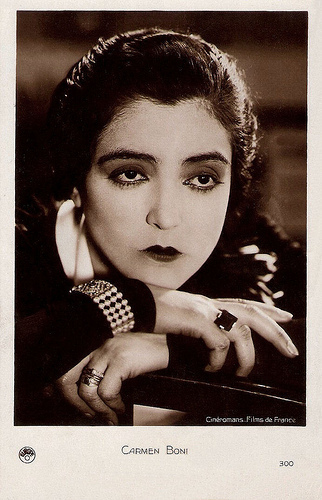
Carmen Boni. French postcard by Europe, no. 300. Photo: Cineromans / Films de France.
White Telephones
When sound film set in, Camillo Pilotto immediately had a part in the first sound film La canzone dell’amore/The Song of Love (Gennaro Righelli, 1930). The film was based very loosely on a Luigi Pirandello short story called In silenzio/In Silence about a woman, Lucia ( Dria Paola ), who cares for her widowed mother's out-of-wedlock child.
Pilotto played the ex-lover of the mother who suddenly claims the child, but eventually lets Lucia have the child, when he notices how desperately she wants the baby. According to Gerald A. DeLuca at IMDb : "La canzone dell'amore (The Song of Love) was extraordinarily popular at the time of its release in Italy, and critics praised its beauty and skill at the hands of director Gennaro Righelli as well as the performances, especially that of Dria Paola ."
Next, Pilotto starred opposite Carmen Boni in the Italian-language Paramount productions La vacanza del diavolo/The Devil's Holiday (Jack Salvatori, 1931), and La riva dei bruti (Mario Camerini, 1931).
In the early 1930s, Pilotto became one of the major actors within ‘Telefoni Bianchi’ films, the Italian romantic comedy genre made by such directors as Nunzio Malasomma (La telefonista/The Telephone Operator (1932)), Amleto Palermi (La segretaria per tutti/The Secretary for Everything (1933)), and Alessandro Blasetti (Il caso Haller/The Haller Case (1933) starring Isa Miranda ).
However, he also played the memorable parts of the depraved Duke Alessandro in Lorenzino de’Medici/The Magnificent Rogue (Guido Brignone, 1936), starring Alexander Moissi , and Hannibal, the one-eyed, lustful and streetwise opponent of the Roman leader Scipio ( Annibale Ninchi ) in the epic production Scipione l’Africano/Scipio Africanus: The Defeat of Hannibal (Carmine Gallone, 1937).
This was also the start of a series of parts in heroic historical and contemporary films like Pietro Micca (Aldo Vergano, 1938) and Abuna Messias/Cardinal Messias (Goffredo Alessandrini, 1939). The latter film was a controversial historical legitimation for the war in Abysinnia.
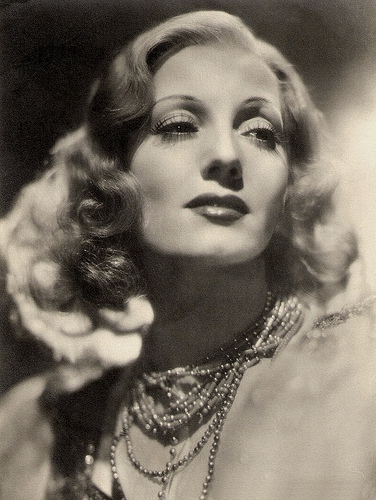
Isa Miranda . Italian postcard by ASER (A. Scarmiglia Ed.), Rome.
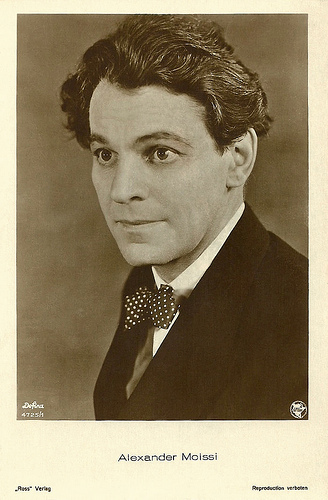
Alexander Moissi . German postcard by Ross Verlag, no. 4725/1, 1929-1930. Photo: Defina.
The Italian Voice of Wallace Beery
Camillo Pilotto also had important parts in two postwar period pieces: Il passatore/Bullet for Stefano (Duilio Coletti, 1947) with Rossano Brazzi , and Penne nere/Black Feathers (Oreste Biancoli, 1952) starring Marcello Mastroianni .
Pilotto was also active in dubbing foreign films and was the Italian voice of Wallace Beery, Eugene Pallette, Victor McLaglen and Henry Stephenson.
All in all Pilotto played in over 50 sound films (until 1952), but also in various television series. Among these were some highly successful ones like Piccolo mondo antico/Small ancient world (Silverio Blasi, 1957), Canne al vento/Reeds to the wind (Mario Landi, 1958), and Il mulino del Po/The Mill of the Po (Sandro Bolchi, 1963) starring Raf Vallone .
Camillo Pilotto’s last performance, in Le anime morte/The dead souls (Edmo Fenoglio, 1963) based on the novel by Nikolai Gogol, was released after his death in Rome, in 1963.
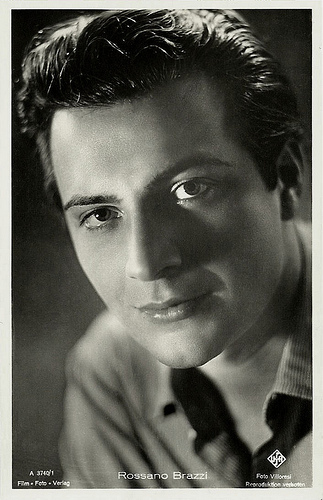
Rossano Brazzi . German postcard by Film-Foto-Verlag, no. A 3740/1, 1941-1944. Photo: Villoresi / Ufa.
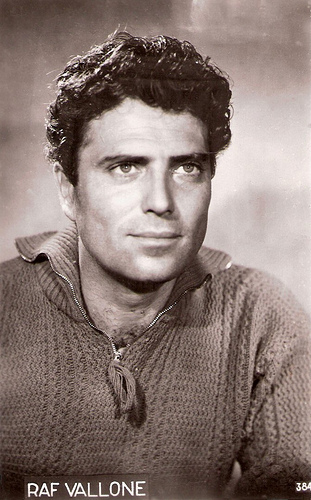
Raf Vallone . French postcard by Editions P.I., Paris, no. 14 E/384.
Sources: Gerald A. DeLuca (IMDb), Wikipedia (Italian) and .

Italian postcard by Agency Aser, no. 92. Photo: Ciolfi.

German postcard by Film-Foto-Verlag, no. A 4091/1, 1941-1944. Photo: Binz / Difu.
Personally Attached to Pirandello
Camillo Pilotto was born in Roma (Rome) in 1888 (according to Wikipedia ; IMDb mentions 1890). He was the son of actor and stagewriter Libero Pilotto.
In 1903, at the age of 15, he started to perform on stage with the company of Ermete Novelli and continued to perform with the most renowned theatre companies until the late 1950s.
Remarkable in the postwar era was his part of Cotrone in Luigi Pirandello’s I giganti della montagna, directed by Giorgio Strehler. Pilotto was personally attached to Pirandello.
Pilotto’s film debut happened in 1916 in Il sopravissuto (Augusto Genina, 1916) after which a handful of silent films followed, including La capanna dello zio Tom/Uncle Tom's Cabin (Riccardo Tolentino, 1918), based on the novel by Harriet Beecher Stowe.
During the 1920s Pilotto was hardly seen in the cinema, but his career as a film actor really set off in the 1930s.

Ermete Novelli . Italian postcard by Alterocca, Terni, no. 513.

Carmen Boni. French postcard by Europe, no. 300. Photo: Cineromans / Films de France.
White Telephones
When sound film set in, Camillo Pilotto immediately had a part in the first sound film La canzone dell’amore/The Song of Love (Gennaro Righelli, 1930). The film was based very loosely on a Luigi Pirandello short story called In silenzio/In Silence about a woman, Lucia ( Dria Paola ), who cares for her widowed mother's out-of-wedlock child.
Pilotto played the ex-lover of the mother who suddenly claims the child, but eventually lets Lucia have the child, when he notices how desperately she wants the baby. According to Gerald A. DeLuca at IMDb : "La canzone dell'amore (The Song of Love) was extraordinarily popular at the time of its release in Italy, and critics praised its beauty and skill at the hands of director Gennaro Righelli as well as the performances, especially that of Dria Paola ."
Next, Pilotto starred opposite Carmen Boni in the Italian-language Paramount productions La vacanza del diavolo/The Devil's Holiday (Jack Salvatori, 1931), and La riva dei bruti (Mario Camerini, 1931).
In the early 1930s, Pilotto became one of the major actors within ‘Telefoni Bianchi’ films, the Italian romantic comedy genre made by such directors as Nunzio Malasomma (La telefonista/The Telephone Operator (1932)), Amleto Palermi (La segretaria per tutti/The Secretary for Everything (1933)), and Alessandro Blasetti (Il caso Haller/The Haller Case (1933) starring Isa Miranda ).
However, he also played the memorable parts of the depraved Duke Alessandro in Lorenzino de’Medici/The Magnificent Rogue (Guido Brignone, 1936), starring Alexander Moissi , and Hannibal, the one-eyed, lustful and streetwise opponent of the Roman leader Scipio ( Annibale Ninchi ) in the epic production Scipione l’Africano/Scipio Africanus: The Defeat of Hannibal (Carmine Gallone, 1937).
This was also the start of a series of parts in heroic historical and contemporary films like Pietro Micca (Aldo Vergano, 1938) and Abuna Messias/Cardinal Messias (Goffredo Alessandrini, 1939). The latter film was a controversial historical legitimation for the war in Abysinnia.

Isa Miranda . Italian postcard by ASER (A. Scarmiglia Ed.), Rome.

Alexander Moissi . German postcard by Ross Verlag, no. 4725/1, 1929-1930. Photo: Defina.
The Italian Voice of Wallace Beery
Camillo Pilotto also had important parts in two postwar period pieces: Il passatore/Bullet for Stefano (Duilio Coletti, 1947) with Rossano Brazzi , and Penne nere/Black Feathers (Oreste Biancoli, 1952) starring Marcello Mastroianni .
Pilotto was also active in dubbing foreign films and was the Italian voice of Wallace Beery, Eugene Pallette, Victor McLaglen and Henry Stephenson.
All in all Pilotto played in over 50 sound films (until 1952), but also in various television series. Among these were some highly successful ones like Piccolo mondo antico/Small ancient world (Silverio Blasi, 1957), Canne al vento/Reeds to the wind (Mario Landi, 1958), and Il mulino del Po/The Mill of the Po (Sandro Bolchi, 1963) starring Raf Vallone .
Camillo Pilotto’s last performance, in Le anime morte/The dead souls (Edmo Fenoglio, 1963) based on the novel by Nikolai Gogol, was released after his death in Rome, in 1963.

Rossano Brazzi . German postcard by Film-Foto-Verlag, no. A 3740/1, 1941-1944. Photo: Villoresi / Ufa.

Raf Vallone . French postcard by Editions P.I., Paris, no. 14 E/384.
Sources: Gerald A. DeLuca (IMDb), Wikipedia (Italian) and .
Published on March 09, 2016 22:00
March 8, 2016
Imported from the USA: Rita Hayworth
Sultry Rita Hayworth (1918-1987) was an American dancer and actress was one of the top pin-up girl for GIs during World War II. Her beauty catapulted her to international stardom and she is best known for her sexy performance in the Film Noir Gilda (1946). Later in her career she also appeared in European films.
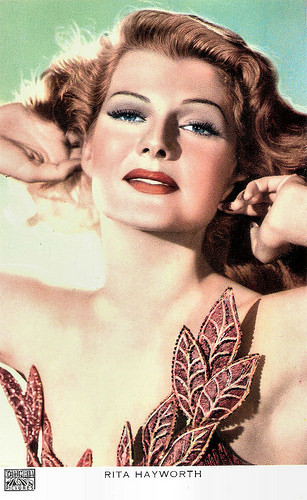
Belgian postcard by Victoria, Brussels, no. 639. Photo: Columbia Pictures.
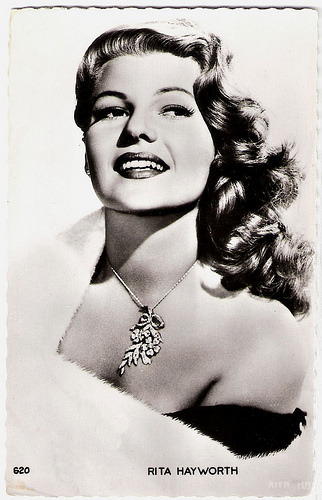
German postcard by Editions P.I., no. 620. Photo: Columbia.
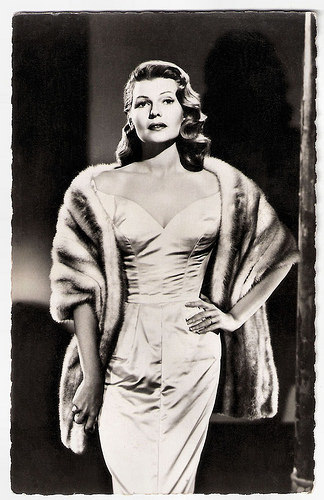
French postcard by Editions P.I., no. 843. Photo: Browning Studio.
Put the Blame on Mame
Rita Hayworth was born in Brooklyn, New York in 1918 as Margarita Carmen Cansino. She was the oldest child of two dancers, Eduardo Cansino, Sr., from Castilleja de la Cuesta, a little town near Seville, Spain, and Volga Hayworth, an American of Irish-English descent who had performed with the Ziegfeld Follies. Margarita had two brothers, Eduardo Cansino, Jr. and Vernon Cansino. Margarita's father wanted her to become a professional dancer, while her mother hoped she would become an actress.
She performed publicly from the age of six. In 1926 at the age of eight, she was featured with the dancing Cansino family in the Vitaphone short La Fiesta (1926). In 1927, her father took the family to Hollywood. He believed that dancing could be featured in the movies and that his family could be part of it. He established his own dance studio, where he taught such stars as James Cagney and Jean Harlow. In 1931 Eduardo Cansino partnered with his 12-year-old but mature-looking daughter to form an act called the Dancing Cansinos.
Margarita took a bit part in the Mexican film Cruz Diablo (Fernando de Fuentes, 1934) at age 16, which led to another in the Hollywood production In Caliente (Lloyd Bacon, 1935) with the Mexican actress, Dolores del Río. She danced with her father in such nightspots as the Foreign and the Caliente clubs. Winfield Sheehan, the head of the Fox Film Corporation, saw her dancing at the Caliente Club and quickly arranged for Hayworth to do a screen test a week later. Impressed by her screen persona, Sheehan signed her for a short-term six-month contract at Fox, under the name Rita Cansino, the first of two name changes for her film career.
During her time at Fox, Rita appeared in unremarkable roles, often cast as the exotic foreigner. She had her first speaking role as an Argentinian girl in the romantic Western Under the Pampas Moon (James Tinling, 1935). By the end of her six-month contract, Fox had merged into 20th Century Fox, with Darryl F. Zanuck serving as the executive producer. Zanuck did not renew Hayworth's contract. Feeling that Hayworth had screen potential, salesman and promoter Edward C. Judson, who became her first husband in 1937, got her freelance work in several small-studio films and a part in the Columbia Pictures feature Meet Nero Wolfe (Herbert J. Biberman, 1936).
Columbia Studio head Harry Cohn signed her to a seven-year contract and tried her out in small roles. Cohn argued that Hayworth's image was too Mediterranean, which reduced her opportunities to being cast in 'exotic' roles that were fewer in number. Rita Cansino became Rita Hayworth when she adopted her mother's maiden name, to the consternation of her father. At the urging of husband Eddie Judson, she changed her hair colour to dark red and had electrolysis to raise her hairline and broaden the appearance of her forehead. In 1939, Cohn pressured director Howard Hawks to use Hayworth for a small but important role as a man-trap in the aviation drama Only Angels Have Wings (1939), opposite Cary Grant. With this film's box-office success, fan mail for Hayworth began pouring into Columbia's publicity department. Cohn began to see Hayworth as his first and official new star.
While on loan to Warner Bros., Hayworth appeared as the second female lead in The Strawberry Blonde (Raoul Walsh, 1941), opposite James Cagney. Because the film was a big box-office success, Hayworth's popularity rose and she immediately became one of Hollywood's hottest actresses. A Bob Landry photo of Rita in Life magazine, 11 August 1941, made her the number 2 soldier pin-up of World War II. That same year the 'American film goddess' shared the dance floor with Fred Astaire in You'll Never Get Rich (Sidney Lanfield, 1941). This musical was so successful, the studio produced and released another Astaire-Hayworth picture the following year, You Were Never Lovelier (William A. Seiter, 1942).
Under of the influence of second husband Orson Welles , Rita began to read classic literature. While pregnant in 1944, she was impressed by Sir Walter Scott's Ivanhoe and named her firstborn daughter Rebecca after the novel's heroine. That year, Hayworth had top billing in one of her best-known films, the Technicolor musical Cover Girl (Charles Vidor, 1944) with Gene Kelly. Cohn continued to showcase Hayworth's dance talents and featured her in the Technicolor films Tonight and Every Night (Victor Saville, 1945), and Down to Earth (Alexander Hall, 1947) with Larry Parks.
Rita Hayworth is best known for her dramatic performance opposite Glenn Ford in the Film Noir Gilda (Charles Vidor, 1946). The film included a controversial (tame by today's standards) striptease by Hayworth. Singing Put The Blame On Mame, she wore black satin and performed a one-glove striptease. It made her into a cultural icon as a femme fatale. The following year she starred in another Film Noir favorite, The Lady From Shanghai (1947), which was directed by her then-husband, Orson Welles . Hayworth's performance was critically acclaimed. The film's failure at the box office was attributed in part to Hayworth's famous red hair being cut short and bleached platinum blonde for the role. Cohn had not been consulted and was furious that Hayworth's image was changed.
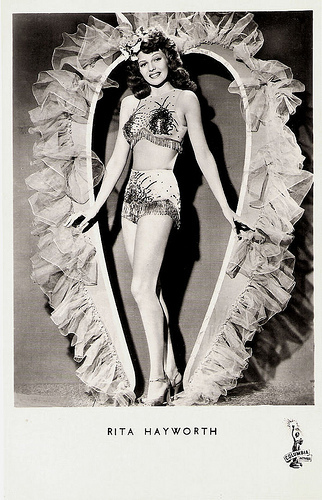
German postcard by Kunst und Bild, Berlin, no. A 124. Photo: Columbia.
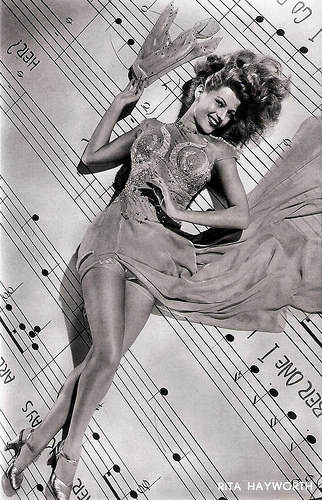
Dutch postcard, Col. Int., no. 286. Photo: Columbia. Publicity still for Cover Girl (Charles Vidor, 1944).
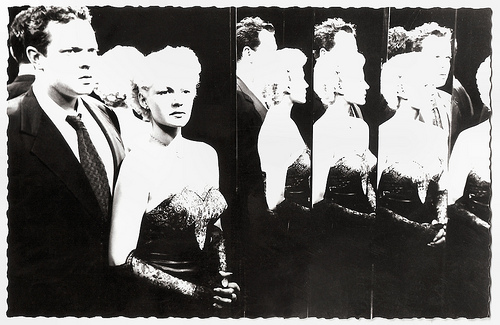
Vintage postcard. Photo: publicity still for The Lady From Shanghai (Orson Welles, 1947) with Orson Welles .
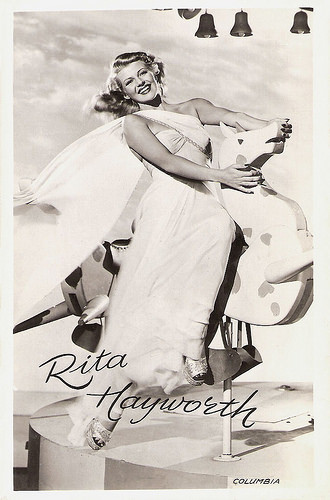
Dutch postcard by Takken / 't Sticht, no. 3317. Photo: Columbia. Publicity still for Down to earth (Alexander Hall, 1947).
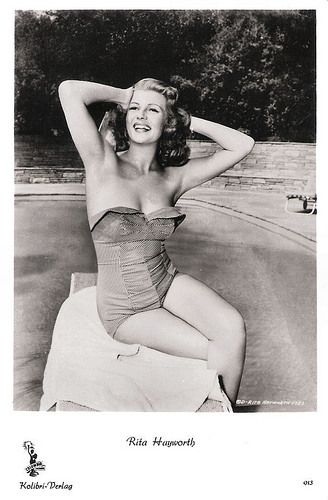
German postcard by Kolibri-Verlag, no. 913. Photo: Columbia.
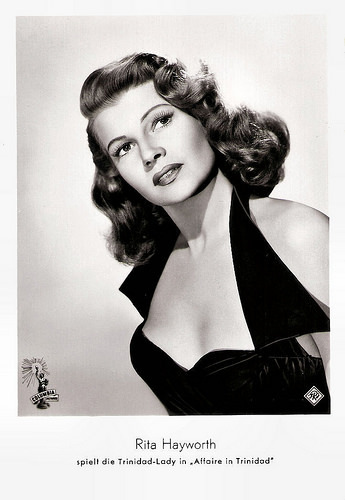
German postcard by F.J. Rüdel Filmpostkartenverlag, Hamburg-Bergedorf, no. 423. Photo: Columbia. Publicity still for Affair in Trinidad (Vincent Sherman, 1952).
A little-known disease
In 1948, at the height of her fame, Rita Hayworth travelled to Cannes and was introduced to Prince Aly Khan. They began a year-long courtship, and were married in 1949. Hayworth left Hollywood and sailed for France, breaking her contract with Columbia. Hayworth gave birth to the couple's only daughter, Princess Yasmin Aga Khan. However, the marriage did not work out. In 1951, Hayworth set sail with her two daughters for New York. Although the couple did reconcile for a short time, they officially divorced by 1953.
Hayworth was forced to return to Hollywood to star in her 'comeback' picture, Affair in Trinidad (Vincent Sherman, 1952) which again paired her with Glenn Ford. Next, she starred in the Biblical epic Salome (William Dieterle, 1953) with Charles Laughton and Stewart Granger , the 3D musical Miss Sadie Thompson (Curtis Bernhardt, 1953), and the British-American adventure drama Fire Down Below (Robert Parrish, 1957). In between these films, she was off the big screen for another four years, mainly because of a tumultuous marriage to the singer Dick Haymes. After the musical Pal Joey (George Sidney, 1957) with Frank Sinatra and Kim Novak, Hayworth left Columbia for good.
Rita Hayworth received good reviews for her performance in Separate Tables (Delbert Mann, 1958), with Burt Lancaster and David Niven . The film was nominated for seven Oscars including Best Picture. Hayworth was married to co-producer James Hill at the time. Another critical success was The Story on Page One (Clifford Odets, 1960) with Anthony Franciosa. She continued working throughout the 1960s. For her part in Circus World (Henry Hathaway, 1964) she earned a Golden Globe nomination.
She also appeared in some European films. In Italy, she made the war-drama L'avventuriero/The Rover (Terence Young, 1967), based on the novel by Joseph Conrad and co-starring Anthony Quinn and Rosanna Schiaffino . In France, she appeared in the psychological thriller La route de Salina/Road to Salina (Georges Lautner, 1970), starring Robert Walker, Jr. and Mimsy Farmer. Her career ended with Ralph Nelson's offbeat Western The Wrath of God (1972), starring Robert Mitchum.
In 1980, Rita Hayworth was diagnosed with Alzheimer's disease, which contributed to her death at age 68. The public disclosure and discussion of her illness drew international attention to Alzheimer's, then a little-known disease, and helped to greatly increase public and private funding for Alzheimer's research.
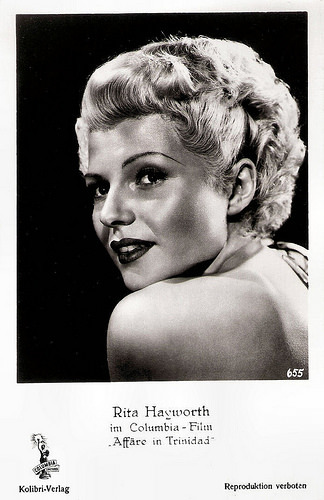
German postcard by Kolibri-Verlag, no. 655. Photo: Columbia-Film. Publicity still for Affair in Trinidad (Vincent Sherman, 1952).
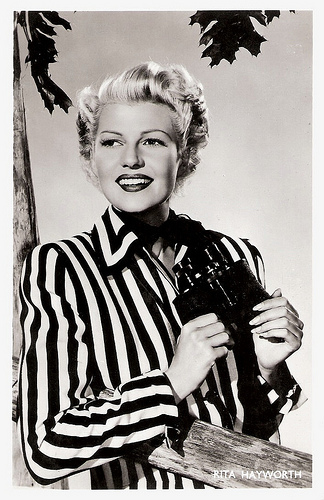
Dutch postcard by J. Sleding, Amsterdam, no. 913. Photo: Europa Film n.v.
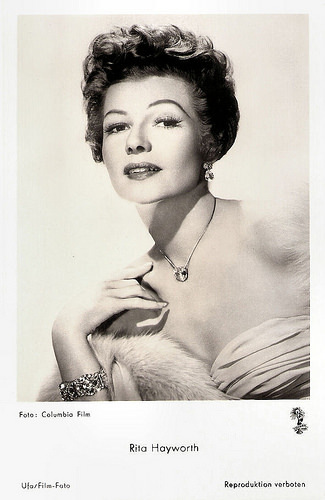
German postcard by Ufa, Berlin-Tempelhof, no. 4252. Photo: Columbia Film. Publicity still for Pal Joey (George Sidney, 1957).
Trailer for The Lady From Shanghai (1947). Source: MUBI UK (YouTube).
Trailer for Road To Salina (1970). Source: FulciLives (YouTube).
Sources: bio., Wikipedia and .

Belgian postcard by Victoria, Brussels, no. 639. Photo: Columbia Pictures.

German postcard by Editions P.I., no. 620. Photo: Columbia.

French postcard by Editions P.I., no. 843. Photo: Browning Studio.
Put the Blame on Mame
Rita Hayworth was born in Brooklyn, New York in 1918 as Margarita Carmen Cansino. She was the oldest child of two dancers, Eduardo Cansino, Sr., from Castilleja de la Cuesta, a little town near Seville, Spain, and Volga Hayworth, an American of Irish-English descent who had performed with the Ziegfeld Follies. Margarita had two brothers, Eduardo Cansino, Jr. and Vernon Cansino. Margarita's father wanted her to become a professional dancer, while her mother hoped she would become an actress.
She performed publicly from the age of six. In 1926 at the age of eight, she was featured with the dancing Cansino family in the Vitaphone short La Fiesta (1926). In 1927, her father took the family to Hollywood. He believed that dancing could be featured in the movies and that his family could be part of it. He established his own dance studio, where he taught such stars as James Cagney and Jean Harlow. In 1931 Eduardo Cansino partnered with his 12-year-old but mature-looking daughter to form an act called the Dancing Cansinos.
Margarita took a bit part in the Mexican film Cruz Diablo (Fernando de Fuentes, 1934) at age 16, which led to another in the Hollywood production In Caliente (Lloyd Bacon, 1935) with the Mexican actress, Dolores del Río. She danced with her father in such nightspots as the Foreign and the Caliente clubs. Winfield Sheehan, the head of the Fox Film Corporation, saw her dancing at the Caliente Club and quickly arranged for Hayworth to do a screen test a week later. Impressed by her screen persona, Sheehan signed her for a short-term six-month contract at Fox, under the name Rita Cansino, the first of two name changes for her film career.
During her time at Fox, Rita appeared in unremarkable roles, often cast as the exotic foreigner. She had her first speaking role as an Argentinian girl in the romantic Western Under the Pampas Moon (James Tinling, 1935). By the end of her six-month contract, Fox had merged into 20th Century Fox, with Darryl F. Zanuck serving as the executive producer. Zanuck did not renew Hayworth's contract. Feeling that Hayworth had screen potential, salesman and promoter Edward C. Judson, who became her first husband in 1937, got her freelance work in several small-studio films and a part in the Columbia Pictures feature Meet Nero Wolfe (Herbert J. Biberman, 1936).
Columbia Studio head Harry Cohn signed her to a seven-year contract and tried her out in small roles. Cohn argued that Hayworth's image was too Mediterranean, which reduced her opportunities to being cast in 'exotic' roles that were fewer in number. Rita Cansino became Rita Hayworth when she adopted her mother's maiden name, to the consternation of her father. At the urging of husband Eddie Judson, she changed her hair colour to dark red and had electrolysis to raise her hairline and broaden the appearance of her forehead. In 1939, Cohn pressured director Howard Hawks to use Hayworth for a small but important role as a man-trap in the aviation drama Only Angels Have Wings (1939), opposite Cary Grant. With this film's box-office success, fan mail for Hayworth began pouring into Columbia's publicity department. Cohn began to see Hayworth as his first and official new star.
While on loan to Warner Bros., Hayworth appeared as the second female lead in The Strawberry Blonde (Raoul Walsh, 1941), opposite James Cagney. Because the film was a big box-office success, Hayworth's popularity rose and she immediately became one of Hollywood's hottest actresses. A Bob Landry photo of Rita in Life magazine, 11 August 1941, made her the number 2 soldier pin-up of World War II. That same year the 'American film goddess' shared the dance floor with Fred Astaire in You'll Never Get Rich (Sidney Lanfield, 1941). This musical was so successful, the studio produced and released another Astaire-Hayworth picture the following year, You Were Never Lovelier (William A. Seiter, 1942).
Under of the influence of second husband Orson Welles , Rita began to read classic literature. While pregnant in 1944, she was impressed by Sir Walter Scott's Ivanhoe and named her firstborn daughter Rebecca after the novel's heroine. That year, Hayworth had top billing in one of her best-known films, the Technicolor musical Cover Girl (Charles Vidor, 1944) with Gene Kelly. Cohn continued to showcase Hayworth's dance talents and featured her in the Technicolor films Tonight and Every Night (Victor Saville, 1945), and Down to Earth (Alexander Hall, 1947) with Larry Parks.
Rita Hayworth is best known for her dramatic performance opposite Glenn Ford in the Film Noir Gilda (Charles Vidor, 1946). The film included a controversial (tame by today's standards) striptease by Hayworth. Singing Put The Blame On Mame, she wore black satin and performed a one-glove striptease. It made her into a cultural icon as a femme fatale. The following year she starred in another Film Noir favorite, The Lady From Shanghai (1947), which was directed by her then-husband, Orson Welles . Hayworth's performance was critically acclaimed. The film's failure at the box office was attributed in part to Hayworth's famous red hair being cut short and bleached platinum blonde for the role. Cohn had not been consulted and was furious that Hayworth's image was changed.

German postcard by Kunst und Bild, Berlin, no. A 124. Photo: Columbia.

Dutch postcard, Col. Int., no. 286. Photo: Columbia. Publicity still for Cover Girl (Charles Vidor, 1944).

Vintage postcard. Photo: publicity still for The Lady From Shanghai (Orson Welles, 1947) with Orson Welles .

Dutch postcard by Takken / 't Sticht, no. 3317. Photo: Columbia. Publicity still for Down to earth (Alexander Hall, 1947).

German postcard by Kolibri-Verlag, no. 913. Photo: Columbia.

German postcard by F.J. Rüdel Filmpostkartenverlag, Hamburg-Bergedorf, no. 423. Photo: Columbia. Publicity still for Affair in Trinidad (Vincent Sherman, 1952).
A little-known disease
In 1948, at the height of her fame, Rita Hayworth travelled to Cannes and was introduced to Prince Aly Khan. They began a year-long courtship, and were married in 1949. Hayworth left Hollywood and sailed for France, breaking her contract with Columbia. Hayworth gave birth to the couple's only daughter, Princess Yasmin Aga Khan. However, the marriage did not work out. In 1951, Hayworth set sail with her two daughters for New York. Although the couple did reconcile for a short time, they officially divorced by 1953.
Hayworth was forced to return to Hollywood to star in her 'comeback' picture, Affair in Trinidad (Vincent Sherman, 1952) which again paired her with Glenn Ford. Next, she starred in the Biblical epic Salome (William Dieterle, 1953) with Charles Laughton and Stewart Granger , the 3D musical Miss Sadie Thompson (Curtis Bernhardt, 1953), and the British-American adventure drama Fire Down Below (Robert Parrish, 1957). In between these films, she was off the big screen for another four years, mainly because of a tumultuous marriage to the singer Dick Haymes. After the musical Pal Joey (George Sidney, 1957) with Frank Sinatra and Kim Novak, Hayworth left Columbia for good.
Rita Hayworth received good reviews for her performance in Separate Tables (Delbert Mann, 1958), with Burt Lancaster and David Niven . The film was nominated for seven Oscars including Best Picture. Hayworth was married to co-producer James Hill at the time. Another critical success was The Story on Page One (Clifford Odets, 1960) with Anthony Franciosa. She continued working throughout the 1960s. For her part in Circus World (Henry Hathaway, 1964) she earned a Golden Globe nomination.
She also appeared in some European films. In Italy, she made the war-drama L'avventuriero/The Rover (Terence Young, 1967), based on the novel by Joseph Conrad and co-starring Anthony Quinn and Rosanna Schiaffino . In France, she appeared in the psychological thriller La route de Salina/Road to Salina (Georges Lautner, 1970), starring Robert Walker, Jr. and Mimsy Farmer. Her career ended with Ralph Nelson's offbeat Western The Wrath of God (1972), starring Robert Mitchum.
In 1980, Rita Hayworth was diagnosed with Alzheimer's disease, which contributed to her death at age 68. The public disclosure and discussion of her illness drew international attention to Alzheimer's, then a little-known disease, and helped to greatly increase public and private funding for Alzheimer's research.

German postcard by Kolibri-Verlag, no. 655. Photo: Columbia-Film. Publicity still for Affair in Trinidad (Vincent Sherman, 1952).

Dutch postcard by J. Sleding, Amsterdam, no. 913. Photo: Europa Film n.v.

German postcard by Ufa, Berlin-Tempelhof, no. 4252. Photo: Columbia Film. Publicity still for Pal Joey (George Sidney, 1957).
Trailer for The Lady From Shanghai (1947). Source: MUBI UK (YouTube).
Trailer for Road To Salina (1970). Source: FulciLives (YouTube).
Sources: bio., Wikipedia and .
Published on March 08, 2016 22:00
March 7, 2016
Sylvie Vartan
French pop singer Sylvie Vartan (1944) was one of the first rock girls in France. She was the diva of the yé-yé genre. With Johnny Hallyday she formed France's Golden Couple of their generation, and they performed in several films, together and apart. With her slick stage shows, her sequined costumes and her sheer professionalism she has become a national icon in France.
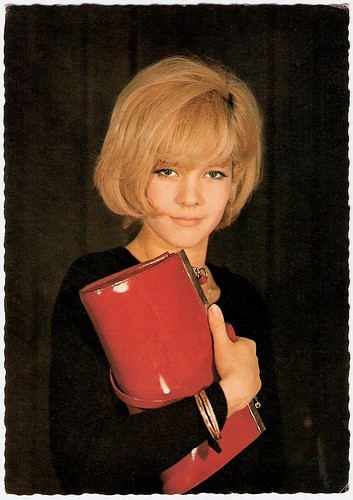
French postcard by Publistar, Marseille, no. 939. Photo: Patrick Bertrand.
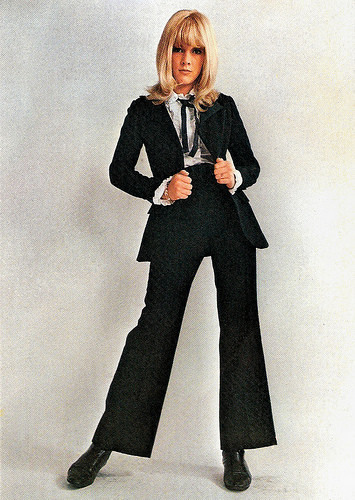
French postcard by E.D.U.G., no. 482. Photo: Jean Marie Perier.
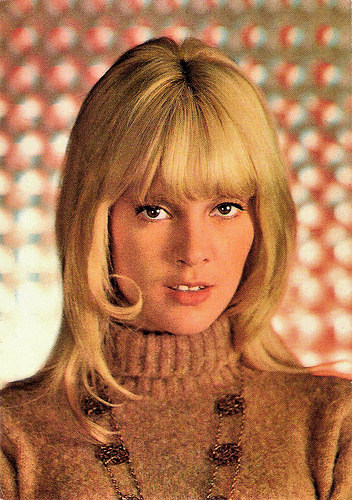
French postcard by E.D.U.G., no. 507. Photo: Sam Lévin.
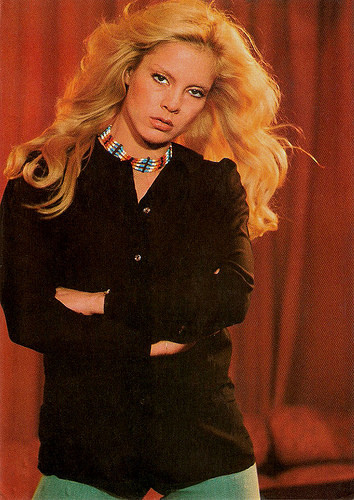
French postcard by Editions Lyna, Paris, no. 2051. Photo: Raymond Depardon / Gamma.
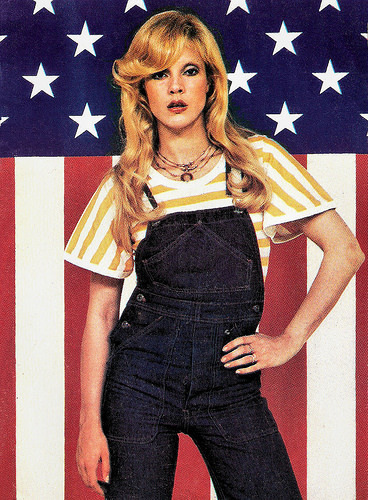
French promotion card by RCA.
The Twisting Schoolgirl
Sylvie Vartan was born in Iskretz near Sofia, Bulgaria. Her father, Georges Vartanian was a Bulgarian of Armenian descent. He worked as an attache at the French embassy in Sofia. Her mother, Illona Vartanian, was Hungarian.
In September 1944, when the Soviet Army occupied Bulgaria, the Vartan family house was nationalised and they moved to Sofia. A friend of father Georges offered Sylvie a role of a schoolgirl in his film Pod igoto/Under the Yoke (Dako Dakovski, 1952). The film was about Bulgarian rebels against the Turkish occupation. Being a part of the film had a lasting impression on her and made her dream of becoming an entertainer.
The family emigrated to Paris in December 1952. By the example of her brother, professional trumpeter and later artistic director at RCA records Eddie Vartan, teenage Sylvie's main interest was music. In 1961 Eddie offered Sylvie to record the song Panne d'essence (Out of gas) with the French rocker Frankie Jordan. It was a surprise hit and provided her first appearance on French TV.
Journalists gave her the nickname La lycéenne du twist. After the Twisting Schoolgirl had finished the Lycée Victor Hugo (Victor Hugo School), she signed a solo recording contract with RCA. Her first single Quand le film est triste, covering Sue Thompson's Sad movies was a hit in December 1961.
Soon followed more hits like her version of The Loco-Motion and Tous mes copains. Six of her thirty-one songs released in 1962 became top 20 hits in Europe. A small part as a singer in Un clair de lune à Maubeuge/Moonlight in Maubeuge (Jean Chérasse, 1962) starring Claude Brasseur was her first film appearance as an adult.
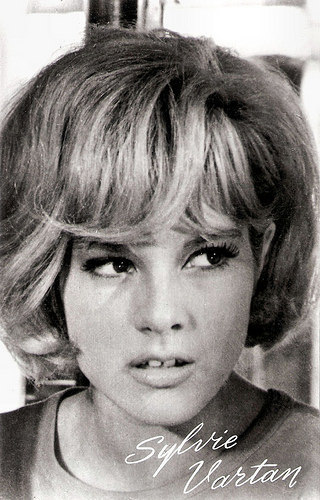
Dutch postcard by Muziek Parade, Hilversum, no. AX 5643.
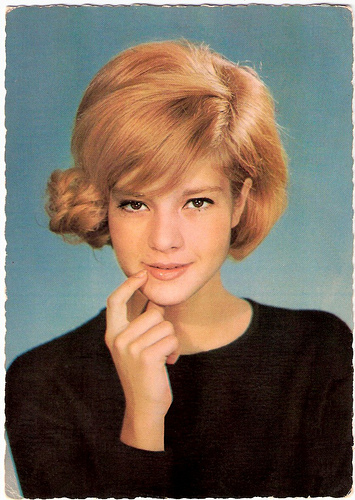
French postcard by E.D.U.G. Publicity card for RCA Victor. Photo: Sam Lévin.
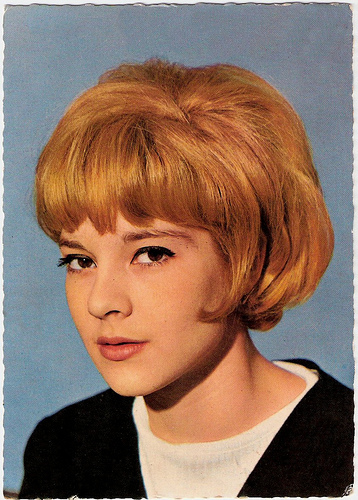
French postcard by Publistar, Marseille, no. 818. Photo: Spitzer.
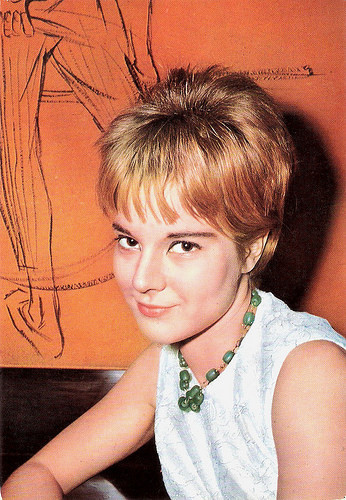
French postcard by Editions P.I., Paris, no. 1092. Photo: Anders.
Short Skirts and Barbarella Boots
In 1962 Sylvie Vartan met Jean-Philippe Smet, better known as Johnny Hallyday , during her second concert in the Olympia. In 1963, after announcing their engagement over the radio, the young couple performed to a noisy audience of 200,000 at La Nation square of Paris.
Sylvie and Johnny appeared together in the film D'où viens-tu, Johnny?/Where Are You From, Johnny? (Noël Howard, 1963). And that year she was voted top French singer in the first pole on the TV programme Salut les copains.
Being accompanied by the film Cherchez l’idole/The Chase (Michel Boisrond, 1964) with Dany Saval , her song La plus belle pour aller danser sold over a million copies in Japan. In 1964 she opened for the Beatles at the Olympia and played a supporting role in the film Patate/Friend of the Family (Robert Thomas, 1964) opposite Jean Marais and Danielle Darrieux .
Sylvie made numerous US TV appearances and an international concert tour, including Canada, South America and Japan. In 1965 Sylvie and Johnny were married in Loconville. They had a son David Michael Benjamin, known now as singer David Hallyday. In 1968 Sylvie suffered a traffic accident, but was back on tour in August.
No longer a shy young yé-yé girl but a sexy dancer, more into cabaret than rock & roll. She appeared often on French and Italian TV, dressed in short skirts and Barbarella boots. In Italy she had huge hits with Zum zum zum in 1968 and Irrestibilmente in 1969. She continued with intensive performing and recording.
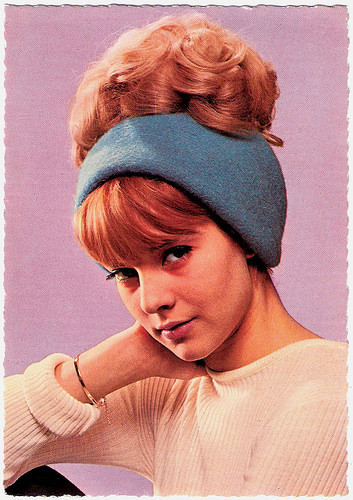
French postcard by E.D.U.G., no. 329. Photo: Sam Lévin / RCA Victor.
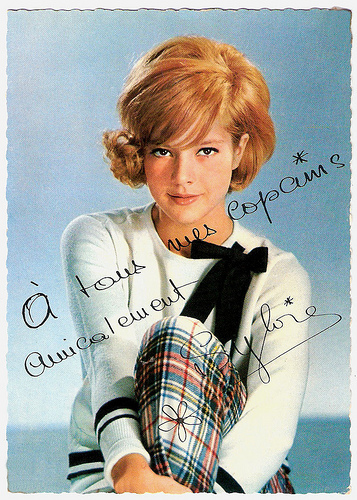
French postcard by E.D.U.G., no. 276. Offered by André. Photo: Sam Lévin.
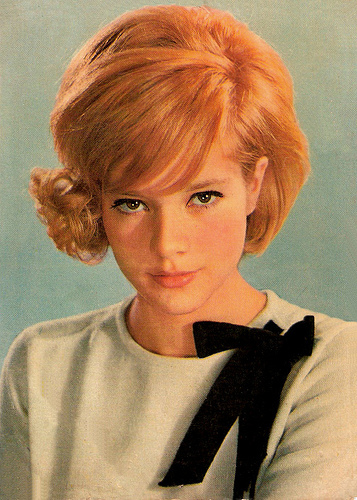
French postcard by E.D.U.G., no. 329. Photo: Sam Lévin / RCA Victor.
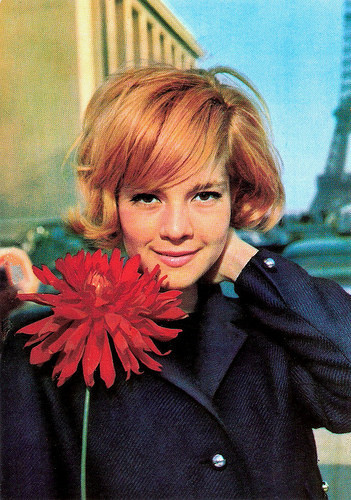
French postcard by Editions P.I., Paris, no. 1116. Photo: Kasparian.
Going Disco
Sylvie Vartan returned on the screen opposite Mathieu Carrière and Orson Welles in the cult film Malpertuis/The Legend of Doom House (1971, Harry Kümel). She also appeared in two documentaries by Francois Reichenbach, J’ai tout donné/I’ve given everything (1971) and Mon Amie Sylvie/My Friend Sylvie (1972).
Musically, she went disco in 1976 with John Kongos' cover Qu'est-ce qui fait pleurer les blondes?, topping the French charts for several weeks. Her disco era climaxed at the Dancing star show on French TV in 1977.
In 1980, after several widely publicised disagreements, Sylvie and Johnny finally divorced. After releasing Love again in duet with John Denver, a #85 single on Billboard Hot 100 in 1984, Vartan took a break in show business. In 1990 she gave a concert at the Palace of Culture of Sofia, opening and closing with a Bulgarian song. This was her first visit to the city after her emigration.
After her brother Eddie was shot in 2001, she took another break in performing public. In fall 2004 she started recording and giving concerts of jazz ballads in the French speaking countries and Japan. Her last film appearances were in L’ange noir/The Black Angel (Jean-Claude Brisseau, 1994) with Michel Piccoli and Tchéky Karyo, and opposite Francis Huster in the TV film Mausolée pour une garce/Mausoleum for a Bitch (Arnaud Sélignac, 2001), adapted from a best-selling novel by Frédéric Dard.
Vartan celebrated her 60th birthday in style in 2004, publishing her autobiography, Entre ombre et lumière (Between Shadow and Light) and releasing a brand new album, simply entitled Sylvie. In the following years several new albums and tours followed. In 2014 she returned to the screen in the French romantic comedy Tu veux ou tu veux pas/Sex, Love & Therapy (Tonie Marshall, 2014) starring Sophie Marceau and Patrick Bruel .
Since 1984, Sylvie Vartan is married to Italian-American producer Tony Scotti. They have adopted a young Bulgarian girl Darina. Sylvie Vartan is an aunt to Eddie Vartan's son, actor Michael Vartan.
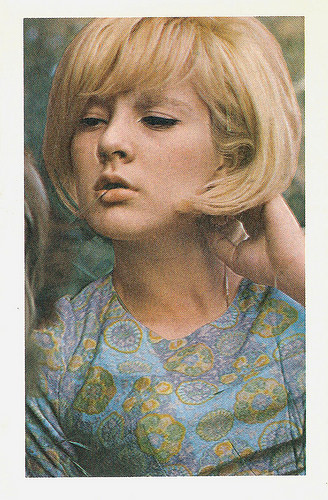
Vintage postcard.
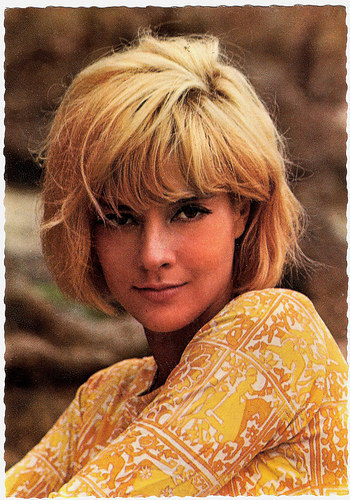
French postcard by E.D.U.G., no. 382. Photo: Philippe D'Argence.
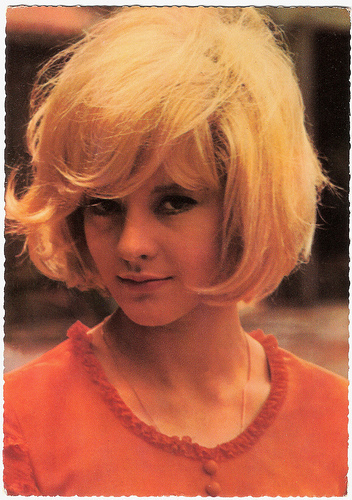
French postcard by PSG, no. 1034. Photo: Laurent Camil / RCA Victor.
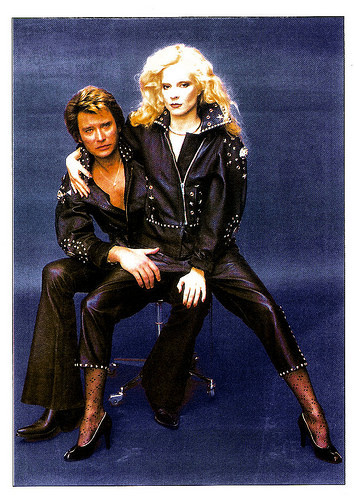
With Johnny Hallyday. French postcard by Carterie Artistique et Cinématographique, Pont du Casse, no. ST JH 13.
Scopitone clip of Sylvie Vartan singing Est ce Que Tu Le Sais. Source: Cheryl Lynn (YouTube).
Sylvie Vartan sings La plus belle pour aller danser in Cherchez l'Idole (1964). Source: win081 (YouTube).
Trailer Malpertuis (1973). Source: retrotrailer (YouTube).
Sources: RFI Musique (French), Wikipedia and .

French postcard by Publistar, Marseille, no. 939. Photo: Patrick Bertrand.

French postcard by E.D.U.G., no. 482. Photo: Jean Marie Perier.

French postcard by E.D.U.G., no. 507. Photo: Sam Lévin.

French postcard by Editions Lyna, Paris, no. 2051. Photo: Raymond Depardon / Gamma.

French promotion card by RCA.
The Twisting Schoolgirl
Sylvie Vartan was born in Iskretz near Sofia, Bulgaria. Her father, Georges Vartanian was a Bulgarian of Armenian descent. He worked as an attache at the French embassy in Sofia. Her mother, Illona Vartanian, was Hungarian.
In September 1944, when the Soviet Army occupied Bulgaria, the Vartan family house was nationalised and they moved to Sofia. A friend of father Georges offered Sylvie a role of a schoolgirl in his film Pod igoto/Under the Yoke (Dako Dakovski, 1952). The film was about Bulgarian rebels against the Turkish occupation. Being a part of the film had a lasting impression on her and made her dream of becoming an entertainer.
The family emigrated to Paris in December 1952. By the example of her brother, professional trumpeter and later artistic director at RCA records Eddie Vartan, teenage Sylvie's main interest was music. In 1961 Eddie offered Sylvie to record the song Panne d'essence (Out of gas) with the French rocker Frankie Jordan. It was a surprise hit and provided her first appearance on French TV.
Journalists gave her the nickname La lycéenne du twist. After the Twisting Schoolgirl had finished the Lycée Victor Hugo (Victor Hugo School), she signed a solo recording contract with RCA. Her first single Quand le film est triste, covering Sue Thompson's Sad movies was a hit in December 1961.
Soon followed more hits like her version of The Loco-Motion and Tous mes copains. Six of her thirty-one songs released in 1962 became top 20 hits in Europe. A small part as a singer in Un clair de lune à Maubeuge/Moonlight in Maubeuge (Jean Chérasse, 1962) starring Claude Brasseur was her first film appearance as an adult.

Dutch postcard by Muziek Parade, Hilversum, no. AX 5643.

French postcard by E.D.U.G. Publicity card for RCA Victor. Photo: Sam Lévin.

French postcard by Publistar, Marseille, no. 818. Photo: Spitzer.

French postcard by Editions P.I., Paris, no. 1092. Photo: Anders.
Short Skirts and Barbarella Boots
In 1962 Sylvie Vartan met Jean-Philippe Smet, better known as Johnny Hallyday , during her second concert in the Olympia. In 1963, after announcing their engagement over the radio, the young couple performed to a noisy audience of 200,000 at La Nation square of Paris.
Sylvie and Johnny appeared together in the film D'où viens-tu, Johnny?/Where Are You From, Johnny? (Noël Howard, 1963). And that year she was voted top French singer in the first pole on the TV programme Salut les copains.
Being accompanied by the film Cherchez l’idole/The Chase (Michel Boisrond, 1964) with Dany Saval , her song La plus belle pour aller danser sold over a million copies in Japan. In 1964 she opened for the Beatles at the Olympia and played a supporting role in the film Patate/Friend of the Family (Robert Thomas, 1964) opposite Jean Marais and Danielle Darrieux .
Sylvie made numerous US TV appearances and an international concert tour, including Canada, South America and Japan. In 1965 Sylvie and Johnny were married in Loconville. They had a son David Michael Benjamin, known now as singer David Hallyday. In 1968 Sylvie suffered a traffic accident, but was back on tour in August.
No longer a shy young yé-yé girl but a sexy dancer, more into cabaret than rock & roll. She appeared often on French and Italian TV, dressed in short skirts and Barbarella boots. In Italy she had huge hits with Zum zum zum in 1968 and Irrestibilmente in 1969. She continued with intensive performing and recording.

French postcard by E.D.U.G., no. 329. Photo: Sam Lévin / RCA Victor.

French postcard by E.D.U.G., no. 276. Offered by André. Photo: Sam Lévin.

French postcard by E.D.U.G., no. 329. Photo: Sam Lévin / RCA Victor.

French postcard by Editions P.I., Paris, no. 1116. Photo: Kasparian.
Going Disco
Sylvie Vartan returned on the screen opposite Mathieu Carrière and Orson Welles in the cult film Malpertuis/The Legend of Doom House (1971, Harry Kümel). She also appeared in two documentaries by Francois Reichenbach, J’ai tout donné/I’ve given everything (1971) and Mon Amie Sylvie/My Friend Sylvie (1972).
Musically, she went disco in 1976 with John Kongos' cover Qu'est-ce qui fait pleurer les blondes?, topping the French charts for several weeks. Her disco era climaxed at the Dancing star show on French TV in 1977.
In 1980, after several widely publicised disagreements, Sylvie and Johnny finally divorced. After releasing Love again in duet with John Denver, a #85 single on Billboard Hot 100 in 1984, Vartan took a break in show business. In 1990 she gave a concert at the Palace of Culture of Sofia, opening and closing with a Bulgarian song. This was her first visit to the city after her emigration.
After her brother Eddie was shot in 2001, she took another break in performing public. In fall 2004 she started recording and giving concerts of jazz ballads in the French speaking countries and Japan. Her last film appearances were in L’ange noir/The Black Angel (Jean-Claude Brisseau, 1994) with Michel Piccoli and Tchéky Karyo, and opposite Francis Huster in the TV film Mausolée pour une garce/Mausoleum for a Bitch (Arnaud Sélignac, 2001), adapted from a best-selling novel by Frédéric Dard.
Vartan celebrated her 60th birthday in style in 2004, publishing her autobiography, Entre ombre et lumière (Between Shadow and Light) and releasing a brand new album, simply entitled Sylvie. In the following years several new albums and tours followed. In 2014 she returned to the screen in the French romantic comedy Tu veux ou tu veux pas/Sex, Love & Therapy (Tonie Marshall, 2014) starring Sophie Marceau and Patrick Bruel .
Since 1984, Sylvie Vartan is married to Italian-American producer Tony Scotti. They have adopted a young Bulgarian girl Darina. Sylvie Vartan is an aunt to Eddie Vartan's son, actor Michael Vartan.

Vintage postcard.

French postcard by E.D.U.G., no. 382. Photo: Philippe D'Argence.

French postcard by PSG, no. 1034. Photo: Laurent Camil / RCA Victor.

With Johnny Hallyday. French postcard by Carterie Artistique et Cinématographique, Pont du Casse, no. ST JH 13.
Scopitone clip of Sylvie Vartan singing Est ce Que Tu Le Sais. Source: Cheryl Lynn (YouTube).
Sylvie Vartan sings La plus belle pour aller danser in Cherchez l'Idole (1964). Source: win081 (YouTube).
Trailer Malpertuis (1973). Source: retrotrailer (YouTube).
Sources: RFI Musique (French), Wikipedia and .
Published on March 07, 2016 22:00
March 6, 2016
Tatyana Konyukhova
Tatyana Konyukhova (1931) is one of the great actresses of the Russian cinema. She started her film career in the 1950s and was still active in the 1990s.
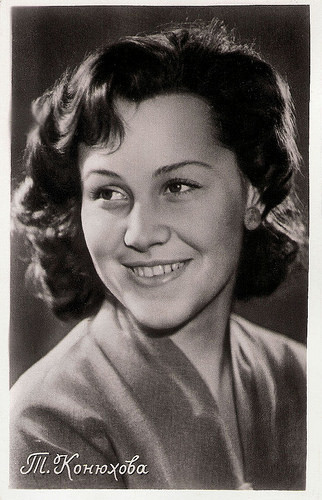
Russian postcard, no. 15, 1959. This postcard was printed in an edition of 100.000 cards. Retail price: 75 Kop.
The Boys from Leningrad
Tatyana Georgiyevna Konyukhova was born in Tashkent, Soviet Union (now Uzbekistan) in 1931. Her film career made a jump start after her debut in Mayskaya Noch, Ili Utoplennitsa/A May Night, or the Drowned Maiden (Aleksandr Rau, 1952). Her second film, Sudba Mariny/Marina’s Destiny (Viktor Ivchenko, Isaak Shmaruk, 1953) was in 1954 nominated for the Grand Prize of the Cannes Film Festival.
Her next film was the successful comedy Zapasnoy igrok/The Boys from Leningrad (Semyon Timoshenko, 1954) about three brothers who are playing for one team in a National Soccer Competition. Tatyana played a beautiful girl for whom one of the brothers loses his heart and his confidence just before the final game.
Other films from this period were Volnitsa/Flames on the Volga (Grigori Roshal, 1955), Dobroe utro (Andrei Frolov, 1955), Pervye radosti/No Ordinary Summer (Vladimir Basov, 1956), and Solntse svetit vsem/The Sun Shines for All (Konstantin Voynov, 1959).
In the 1960s Tatyana Konyukhova went on playing in both film comedies and dramas steadily. Karera Dimy Gorina/Dima Gorin's Career (1961) was a comedy by Frunze Dovlatyan and Lev Mirsky. Zhenitba Balzaminova/The Marriage of Balzaminov (Konstantin Voynov, 1965) was an excellent grotesque about Russian life in the 19th century. The story about a poor clerk searching for a rich wife was based on the plays by Aleksandr Ostrovsky.
Also interesting was the stunning and disturbing anti-war film Csillagosok, katonák/The Red and the White (1967), directed by Hungarian director Miklós Jancsó. It tells the tale of a Hungarian unit that during the civil war supports the Red Army against the counter-revolutionary White army on the banks of the Volga.
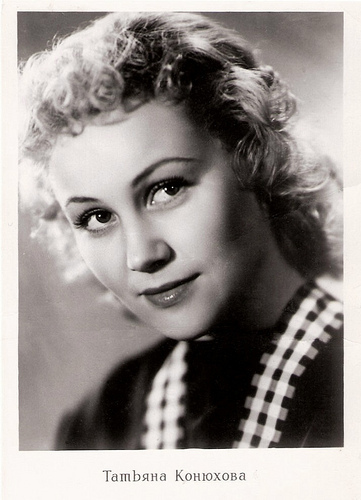
Russian postcard, 1961.
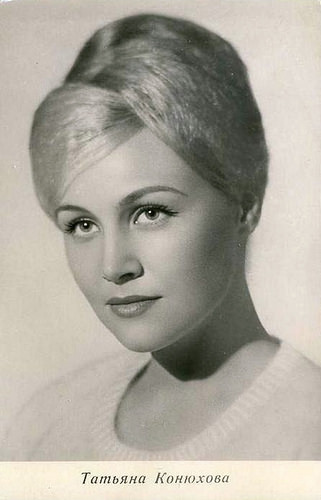
Russian postcard. Collection: Yury Ermolenko (Flickr).
Moscow Doesn’t Believe in Tears
After a hiatus of ten years Tatyana Konyukhova made a come-back playing herself in the Oscar winning Moskva slezam ne verit/Moscow Doesn’t Believe in Tears (Vladimir Menshov, 1980), and in supporting parts in the Bulgarian drama S podelena lyubov/With Shared Love (Sergei Mikaelyan, 1980), and the romance Portret zheny khudozhnika/Portrait of the Artist's Wife (Aleksandr Pankratov, 1981.
Moscow Doesn’t Believe in Tears won the Academy Award for Best Foreign Film. It is an enchanting drama of three women struggling to establish themselves in Moscow. The film follows their resourceful pursuit of professional and domestic bliss in 1958, then skips forward twenty years to see just how many of their dreams have come true.
Some ten more films followed in the 1980s and 1990s. Her more recent films were Nostalgiya po budushemu/Longing for the future (Sergei Tarasov, 2008) about how the economical, mental, political and social attitudes of middle class Russian people have changed over the years, and the family film Zolotaya rybka v gorode N/The Goldfish in City N (Stepan Puchinyan, 2011). Her most recent TV appearance was in the TV-series Printsessa i nishchenka (Stanislav Dremov, 2009).
On IMDb reviewer Lalit Rao commented on Nostalgiya po budushemu/Longing for the future: "Veteran Russian director Sergei Tarasov's film is fairly neutral as far as its political view point is concerned. It is neither critical of communism nor overtly applauds capitalism."
Scene from Csillagosok, katonák/The Red and the White (1967). Source: bikeydoc (YouTube).
Trailer Moskva slezam ne verit/Moscow Doesn’t Believe in Tears (Vladimir Menshov, 1980). Source: Artem Koloskov (YouTube).
Source: All Movie Guide and .

Russian postcard, no. 15, 1959. This postcard was printed in an edition of 100.000 cards. Retail price: 75 Kop.
The Boys from Leningrad
Tatyana Georgiyevna Konyukhova was born in Tashkent, Soviet Union (now Uzbekistan) in 1931. Her film career made a jump start after her debut in Mayskaya Noch, Ili Utoplennitsa/A May Night, or the Drowned Maiden (Aleksandr Rau, 1952). Her second film, Sudba Mariny/Marina’s Destiny (Viktor Ivchenko, Isaak Shmaruk, 1953) was in 1954 nominated for the Grand Prize of the Cannes Film Festival.
Her next film was the successful comedy Zapasnoy igrok/The Boys from Leningrad (Semyon Timoshenko, 1954) about three brothers who are playing for one team in a National Soccer Competition. Tatyana played a beautiful girl for whom one of the brothers loses his heart and his confidence just before the final game.
Other films from this period were Volnitsa/Flames on the Volga (Grigori Roshal, 1955), Dobroe utro (Andrei Frolov, 1955), Pervye radosti/No Ordinary Summer (Vladimir Basov, 1956), and Solntse svetit vsem/The Sun Shines for All (Konstantin Voynov, 1959).
In the 1960s Tatyana Konyukhova went on playing in both film comedies and dramas steadily. Karera Dimy Gorina/Dima Gorin's Career (1961) was a comedy by Frunze Dovlatyan and Lev Mirsky. Zhenitba Balzaminova/The Marriage of Balzaminov (Konstantin Voynov, 1965) was an excellent grotesque about Russian life in the 19th century. The story about a poor clerk searching for a rich wife was based on the plays by Aleksandr Ostrovsky.
Also interesting was the stunning and disturbing anti-war film Csillagosok, katonák/The Red and the White (1967), directed by Hungarian director Miklós Jancsó. It tells the tale of a Hungarian unit that during the civil war supports the Red Army against the counter-revolutionary White army on the banks of the Volga.

Russian postcard, 1961.

Russian postcard. Collection: Yury Ermolenko (Flickr).
Moscow Doesn’t Believe in Tears
After a hiatus of ten years Tatyana Konyukhova made a come-back playing herself in the Oscar winning Moskva slezam ne verit/Moscow Doesn’t Believe in Tears (Vladimir Menshov, 1980), and in supporting parts in the Bulgarian drama S podelena lyubov/With Shared Love (Sergei Mikaelyan, 1980), and the romance Portret zheny khudozhnika/Portrait of the Artist's Wife (Aleksandr Pankratov, 1981.
Moscow Doesn’t Believe in Tears won the Academy Award for Best Foreign Film. It is an enchanting drama of three women struggling to establish themselves in Moscow. The film follows their resourceful pursuit of professional and domestic bliss in 1958, then skips forward twenty years to see just how many of their dreams have come true.
Some ten more films followed in the 1980s and 1990s. Her more recent films were Nostalgiya po budushemu/Longing for the future (Sergei Tarasov, 2008) about how the economical, mental, political and social attitudes of middle class Russian people have changed over the years, and the family film Zolotaya rybka v gorode N/The Goldfish in City N (Stepan Puchinyan, 2011). Her most recent TV appearance was in the TV-series Printsessa i nishchenka (Stanislav Dremov, 2009).
On IMDb reviewer Lalit Rao commented on Nostalgiya po budushemu/Longing for the future: "Veteran Russian director Sergei Tarasov's film is fairly neutral as far as its political view point is concerned. It is neither critical of communism nor overtly applauds capitalism."
Scene from Csillagosok, katonák/The Red and the White (1967). Source: bikeydoc (YouTube).
Trailer Moskva slezam ne verit/Moscow Doesn’t Believe in Tears (Vladimir Menshov, 1980). Source: Artem Koloskov (YouTube).
Source: All Movie Guide and .
Published on March 06, 2016 22:00
March 5, 2016
Georges Rigaud
Georges (or George) Rigaud (1905-1984) was a noted Argentine film actor, who started his career in the French cinema of the 1930s. His best known film is René Clair’s classic comedy Quatorze Juillet (1932). Rigaud also played in Italian, American, Argentine and Spanish films. Between 1932 and 1981, he appeared in 194 films.
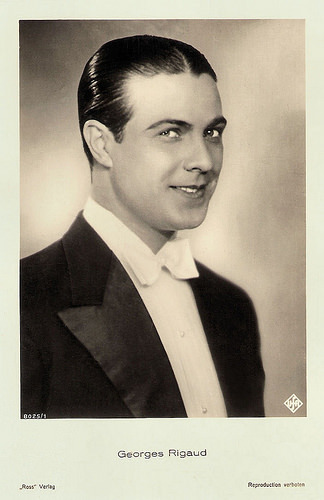
German postcard by Ross Verlag, no. 8025/1, 1933-1934. Photo: Ufa.
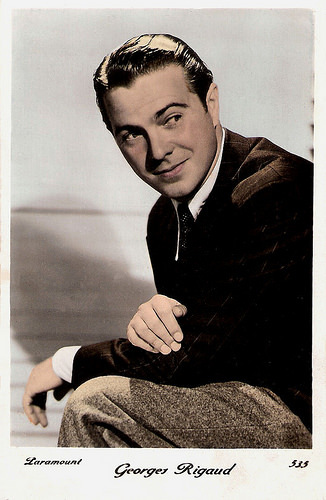
French postcard, no. 535. Photo: Paramount.
14 July
Georges (or George) Rigaud was born Pedro Jorge Rigato Delissetche in Buenos Aires, Argentina, in 1905. In 1931, he moved to France, where he made his film debut with a bit part in Grains de beauté/Beauty Spot (Pierre Caron, Léonce Perret, 1932). That same year he played a bigger role in the crime film Fantômas (Pál Fejös, 1932), starring Jean Galland.
His best known film is René Clair’s classic comedy Quatorze Juillet (1932). Hal Erickson at AllMovie : “Quatorze Juliet translates to "July 14th"--and if you know your French history, you'll know that July 14th is Bastille Day. This Rene Clair film deals not with the tumultuous events of the French Revolution, but with a 1932 celebration of that particular French holiday. The hero, George Rigaud, is a Parisian cabdriver; the heroine, Annabella , is a flower peddler. As the Bastille Day festivities stretch on into the night, the young lovers come in contact with several of Paris' more eccentric citizens. Director Clair felt that Quatorze Juliet was better in parts than in sum total; modern audiences will most likely enjoy the film as a whole, excusing the weaknesses of its structure while revelling in its music and atmosphere.”
The following year, Rigaud starred opposite Renate Müller in the comedy Idylle au Caire (Claude Heymann, Reinhold Schünzel, 1933). It was an alternate language version of the Ufa production Saison in Kairo/Season in Cairo (Reinhold Schünzel, 1933). He then starred in the historical drama Une histoire d'amour/A Love Story (Max Ophüls, 1933), based on Arthur Schnitzler's play Liebelei about a musician's daughter in 1890s Imperial Vienna who falls in love with a young army officer, only for him to be killed in a duel. It is a French-language version of Liebelei (Max Ophüls, 1933).
Popular was also the drama Nitchevo (Jacques de Baroncelli, 1936) starring Harry Baur , which is a remake of the 1926 silent film of the same name. Less successful was the musical La vie parisienne/Parisian Life (Robert Siodmak, 1936) starring Max Dearly, Conchita Montenegro and Rigaud, and based on the opera La vie parisienne. The production caused financial problems for its company, Nero Film, run by the émigré producer Seymour Nebenzal.
Other French films in which he appeared were the drama Nuits de feu/Nights of Fire (Marcel L'Herbier, 1937), starring Gaby Morlay , Sarati, le terrible/Sarati the Terrible (André Hugon, 1937), featuring Harry Baur , and the adventure film Puits en flammes/Wells in Flames (Viktor Tourjansky, 1937).
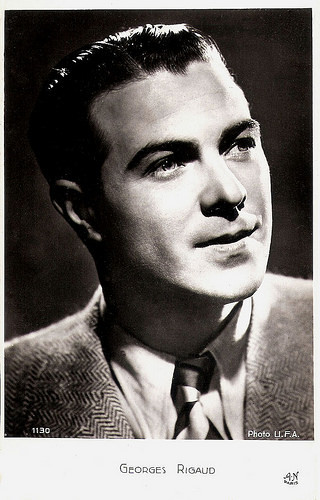
French postcard by A.N., Paris, no. 1130. Photo: Ufa.
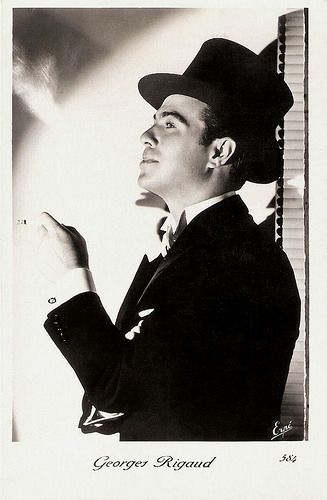
French postcard by Erpé, no. 384.
France - Argentina - Italy - Hollywood - France - Spain
In Italy, Georges Rigaud starred opposite Corinne Luchaire in the drama Abbandono (Mario Mattoli, 1940). Then followed a short period in Hollywood, where he appeared in Paris Underground (Gregory Ratoff, 1945), Masquerade in Mexico (Mitchell Leisen, 1945), and the Film Noir I Walk Alone (Byron Haskin, 1948) starring Burt Lancaster .
After this he returned to Argentina, and co-starred with Zully Moreno in the thriller La trampa/The Trap (Carlos Hugo Christensen, 1949). He had a supporting part in Sangre negra/Native Son (Pierre Chenal, 1951).
In 1957, he moved definitely to Spain, where he continued his film career credited as Jorge Rigaud. His Spanish films include the drama Mi calle/My Street (Edgar Neville, 1960), Vuelve San Valentín/St. Valentine Returns (Fernando Palacios, 1962), and Estambul 65/That Man in Istanbul (Antonio Isasi-Isasmendi, 1965) starring Horst Buchholz .
His parts were now mostly supporting roles. He worked in Italy where he appeared in the Peplum Il Colosso di Rodi/The Colossus of Rhodes (1961), directed by Sergio Leone, and starring Rory Calhoun. In Hollywood he played in the flop The Happy Thieves (George Marshall, 1961), a crime/comedy-drama film starring Rex Harrison and Rita Hayworth. And in France he had a part in the Alain Delon vehicle La Tulipe noire/The Black Tulip (Christian-Jacque, 1964).
Rigaud also was seen in some Eurospy films and Spaghetti Westerns. Interesting were the Italian crime film Ad ogni costo/Grand Slam (Giuliano Montaldo, 1967), starring Janet Leigh, and the Giallo Una lucertola con la pelle di donna/Schizoid (Lucio Fulci, 1971) with Florinda Balkan as the daughter of a respected politician, who experiences a series of vivid, psychedelic nightmares consisting of depraved sex orgies and LSD use. Later films are Pánico en el Transiberian/Horror Express (Eugenio Martín, 1972), starring Christopher Lee and Peter Cushing, and Maravillas (Manuel Gutiérrez Aragón, 1980).
In 1981, Georges Rigaud died in a road accident in Madrid, Spain. He was 78.
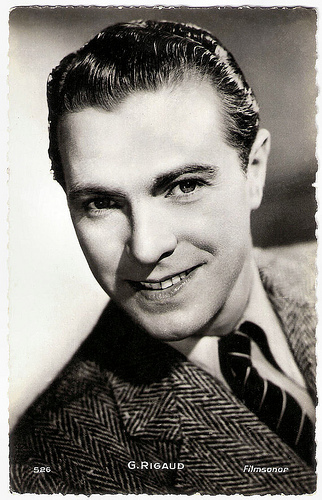
French postcard by Ed. Chantal, no. 526. Photo: Filmsonor.
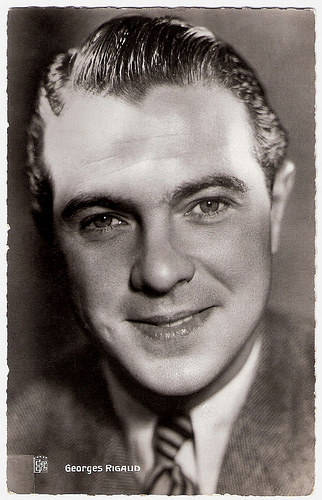
French postcard by Editions et Publications Cinematographiques (EPC), no. 159.
Sources: Hal Erickson (AllMovie), José L. Bernabé Tronchoni (Find A Grave), Wikipedia and .

German postcard by Ross Verlag, no. 8025/1, 1933-1934. Photo: Ufa.

French postcard, no. 535. Photo: Paramount.
14 July
Georges (or George) Rigaud was born Pedro Jorge Rigato Delissetche in Buenos Aires, Argentina, in 1905. In 1931, he moved to France, where he made his film debut with a bit part in Grains de beauté/Beauty Spot (Pierre Caron, Léonce Perret, 1932). That same year he played a bigger role in the crime film Fantômas (Pál Fejös, 1932), starring Jean Galland.
His best known film is René Clair’s classic comedy Quatorze Juillet (1932). Hal Erickson at AllMovie : “Quatorze Juliet translates to "July 14th"--and if you know your French history, you'll know that July 14th is Bastille Day. This Rene Clair film deals not with the tumultuous events of the French Revolution, but with a 1932 celebration of that particular French holiday. The hero, George Rigaud, is a Parisian cabdriver; the heroine, Annabella , is a flower peddler. As the Bastille Day festivities stretch on into the night, the young lovers come in contact with several of Paris' more eccentric citizens. Director Clair felt that Quatorze Juliet was better in parts than in sum total; modern audiences will most likely enjoy the film as a whole, excusing the weaknesses of its structure while revelling in its music and atmosphere.”
The following year, Rigaud starred opposite Renate Müller in the comedy Idylle au Caire (Claude Heymann, Reinhold Schünzel, 1933). It was an alternate language version of the Ufa production Saison in Kairo/Season in Cairo (Reinhold Schünzel, 1933). He then starred in the historical drama Une histoire d'amour/A Love Story (Max Ophüls, 1933), based on Arthur Schnitzler's play Liebelei about a musician's daughter in 1890s Imperial Vienna who falls in love with a young army officer, only for him to be killed in a duel. It is a French-language version of Liebelei (Max Ophüls, 1933).
Popular was also the drama Nitchevo (Jacques de Baroncelli, 1936) starring Harry Baur , which is a remake of the 1926 silent film of the same name. Less successful was the musical La vie parisienne/Parisian Life (Robert Siodmak, 1936) starring Max Dearly, Conchita Montenegro and Rigaud, and based on the opera La vie parisienne. The production caused financial problems for its company, Nero Film, run by the émigré producer Seymour Nebenzal.
Other French films in which he appeared were the drama Nuits de feu/Nights of Fire (Marcel L'Herbier, 1937), starring Gaby Morlay , Sarati, le terrible/Sarati the Terrible (André Hugon, 1937), featuring Harry Baur , and the adventure film Puits en flammes/Wells in Flames (Viktor Tourjansky, 1937).

French postcard by A.N., Paris, no. 1130. Photo: Ufa.

French postcard by Erpé, no. 384.
France - Argentina - Italy - Hollywood - France - Spain
In Italy, Georges Rigaud starred opposite Corinne Luchaire in the drama Abbandono (Mario Mattoli, 1940). Then followed a short period in Hollywood, where he appeared in Paris Underground (Gregory Ratoff, 1945), Masquerade in Mexico (Mitchell Leisen, 1945), and the Film Noir I Walk Alone (Byron Haskin, 1948) starring Burt Lancaster .
After this he returned to Argentina, and co-starred with Zully Moreno in the thriller La trampa/The Trap (Carlos Hugo Christensen, 1949). He had a supporting part in Sangre negra/Native Son (Pierre Chenal, 1951).
In 1957, he moved definitely to Spain, where he continued his film career credited as Jorge Rigaud. His Spanish films include the drama Mi calle/My Street (Edgar Neville, 1960), Vuelve San Valentín/St. Valentine Returns (Fernando Palacios, 1962), and Estambul 65/That Man in Istanbul (Antonio Isasi-Isasmendi, 1965) starring Horst Buchholz .
His parts were now mostly supporting roles. He worked in Italy where he appeared in the Peplum Il Colosso di Rodi/The Colossus of Rhodes (1961), directed by Sergio Leone, and starring Rory Calhoun. In Hollywood he played in the flop The Happy Thieves (George Marshall, 1961), a crime/comedy-drama film starring Rex Harrison and Rita Hayworth. And in France he had a part in the Alain Delon vehicle La Tulipe noire/The Black Tulip (Christian-Jacque, 1964).
Rigaud also was seen in some Eurospy films and Spaghetti Westerns. Interesting were the Italian crime film Ad ogni costo/Grand Slam (Giuliano Montaldo, 1967), starring Janet Leigh, and the Giallo Una lucertola con la pelle di donna/Schizoid (Lucio Fulci, 1971) with Florinda Balkan as the daughter of a respected politician, who experiences a series of vivid, psychedelic nightmares consisting of depraved sex orgies and LSD use. Later films are Pánico en el Transiberian/Horror Express (Eugenio Martín, 1972), starring Christopher Lee and Peter Cushing, and Maravillas (Manuel Gutiérrez Aragón, 1980).
In 1981, Georges Rigaud died in a road accident in Madrid, Spain. He was 78.

French postcard by Ed. Chantal, no. 526. Photo: Filmsonor.

French postcard by Editions et Publications Cinematographiques (EPC), no. 159.
Sources: Hal Erickson (AllMovie), José L. Bernabé Tronchoni (Find A Grave), Wikipedia and .
Published on March 05, 2016 22:00
March 4, 2016
Pierre Richard
French actor Pierre Richard (1934) became popular as a clumsy daydreamer in comedy films of the 1970s. Richard is best known internationally as the star of the zany spy farce Le Grand Blond Avec Une Chassure Noire/The Tall Blond Man with One Black Shoe (1972) and for his hilarious comedies with Gérard Dépardieu. He also wrote and directed several films himself.
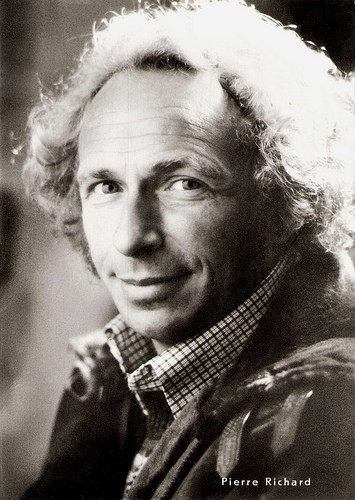
East-German postcard by Progress Film-Verleih, Berlin, no. 161/78.
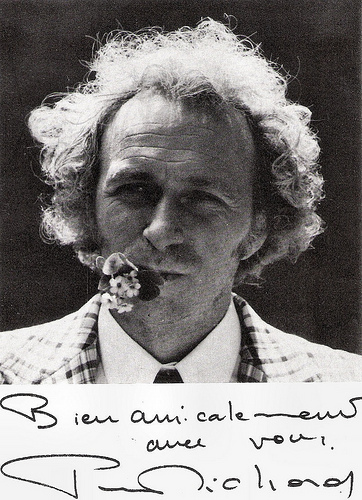
French postcard by La Roue Tourne, Paris.
A Naive Superspy on a Top Secret Mission
Pierre Richard was born Pierre Richard Maurice Charles Leopold Defays in Valenciennes, France, in 1934. His family was upper-class with an embarrassing riches of middle names.
He started his acting career at the theatre and and build up his trade at the Paris Music Hall. In 1958, he made his film debut in a small, uncredited part in the French-Italian drama Les Amants de Montparnasse/The Lovers of Montparnasse (Jacques Becker, 1958), which chronicles the last year of the life of the Italian painter Amedeo Modigliani ( Gérard Philipe ) who worked and died in poverty in the Montparnasse Quarter of Paris.
Ten years later followed the comedy Alexandre le bienheureux/Very Happy Alexander (Yves Robert, 1968), starring Philippe Noiret , in which Richard played a secondary role toward the end of the plot. Two years later he directed and starred in the comedy Le Distrait/The Daydreamer (Pierre Richard, 1970), co-starring Marie-Christine Barrault and Bernard Blier . The film combines elements of a slapstick, horror and romantic comedy. Richard plays Pierre Malaquet, an eccentric and extremely absent-minded advertising manager.
Two years later followed the comedy Les malheurs d'Alfred/The Troubles of Alfred (Pierre Richard, 1972). Alfred (Pierre Richard) is an unemployed architect who is incredibly unlucky, and when he tries to commit suicide, he meets a female television presenter (Anny Duperey) who is pursued by the same misfortune.
That same year, he had his international breakthrough with the comedy hit Le grand blond avec une chaussure noire/The Tall Blond Man with One Black Shoe (1972), directed by Yves Robert and written by Francis Veber. Richard played a naive, innocent concert musician plucked by chance to become a superspy on a top secret mission. The same team made also the sequel, Le retour du grand blond/The Return of the Tall Blond Man (Yves Robert, 1974). Le Grand Blond avec une chaussure noire was remade in English as The Man with One Red Shoe (Stan Dragoti, 1985) with Tom Hanks.
Richard also appeared in several other comedies, frequently teamed with Aldo Maccione. Gary Brumburgh at IMDb : “his characters often have taken on an hilariously guileless persona and, coupled with his innate gift for klutzy physical comedy, have become an audience favourite for nearly four decades.”
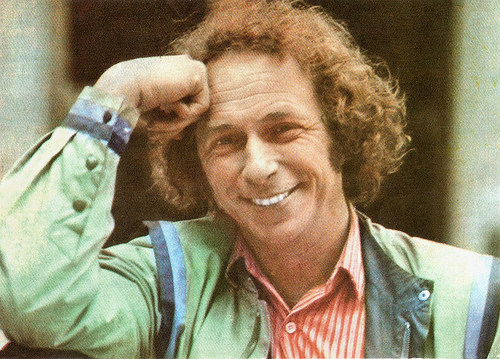
Romanian postcard by Casa Filmului Acin.

German autogram card by Kino, ca. 1989.
One Can Always Dream
Francis Veber cast Pierre Richard while directing his own first feature film: Le Jouet/The Toy (Francis Veber, 1976) with Michel Bouquet. The film was remade in Hollywood as The Toy (Richard Donner, 1982) starring Richard Pryor.
Veber and Richard had a long and successful partnership during the 1980s, highlighted by three comedies – La Chèvre/Knock on Wood (Francis Veber, 1981), Les Compères/ComDads (Francis Veber, 1983) and Les Fugitifs/The Fugitives (Francis Veber, 1986) – which paired Richard as a comic duo with Gérard Depardieu .
All three were remade in Hollywood, the latter as Three Fugitives (1989), also directed by Veber and starring Nick Nolte and Martin Short. However, the many Hollywood remakes and imitations of the films with Richard mostly pale compared to the originals.
Pierre Richard again moved behind the camera to direct On peut toujours rêver/One Can Always Dream (1991) and Droit dans le mur/Straight into the Wall (1997), a dramatic commercial and critical failure. In 2006 the Académie des Arts et Techniques du Cinema awarded him a lifetime achievement César.
In addition to being an actor and film director Pierre Richard is also a businessman. He owns the restaurant Au pied de chameau in Paris and a 20-hectare vineyard in Southern France which produces some 80,000 bottles a year, including some 12,000 bottles of rosé labelled as le Bel Évêque. If he is not overseeing his wine business on location, he lives in Paris. He used to live for many years on a barge on the Seine in the centre of Paris.
Pierre Richard married and divorced three times, and has two sons: Olivier and Christoph, who are both musicians. Olivier is a group member of Blues trottoir and plays the saxophone whereas Christophe plays the double bass. His grandson, Arthur Defays, is a model and a young actor.
Pierre Richard is still very productive in the cinema and one his more recent films is Et si on vivait tous ensemble?/All Together (Stéphane Robelin, 2011) with Geraldine Chaplin and Jane Fonda .
Trailer for Le Jouet/The Toy (1976). Source: Slava Batareykin (YouTube).
International trailer for Et si on vivait tous ensemble?/All Together (2011). Source: Indie & Foreign Films (YouTube).
Sources: Sandra Brennan (AllMovie), (IMDb), Wikipedia and .

East-German postcard by Progress Film-Verleih, Berlin, no. 161/78.

French postcard by La Roue Tourne, Paris.
A Naive Superspy on a Top Secret Mission
Pierre Richard was born Pierre Richard Maurice Charles Leopold Defays in Valenciennes, France, in 1934. His family was upper-class with an embarrassing riches of middle names.
He started his acting career at the theatre and and build up his trade at the Paris Music Hall. In 1958, he made his film debut in a small, uncredited part in the French-Italian drama Les Amants de Montparnasse/The Lovers of Montparnasse (Jacques Becker, 1958), which chronicles the last year of the life of the Italian painter Amedeo Modigliani ( Gérard Philipe ) who worked and died in poverty in the Montparnasse Quarter of Paris.
Ten years later followed the comedy Alexandre le bienheureux/Very Happy Alexander (Yves Robert, 1968), starring Philippe Noiret , in which Richard played a secondary role toward the end of the plot. Two years later he directed and starred in the comedy Le Distrait/The Daydreamer (Pierre Richard, 1970), co-starring Marie-Christine Barrault and Bernard Blier . The film combines elements of a slapstick, horror and romantic comedy. Richard plays Pierre Malaquet, an eccentric and extremely absent-minded advertising manager.
Two years later followed the comedy Les malheurs d'Alfred/The Troubles of Alfred (Pierre Richard, 1972). Alfred (Pierre Richard) is an unemployed architect who is incredibly unlucky, and when he tries to commit suicide, he meets a female television presenter (Anny Duperey) who is pursued by the same misfortune.
That same year, he had his international breakthrough with the comedy hit Le grand blond avec une chaussure noire/The Tall Blond Man with One Black Shoe (1972), directed by Yves Robert and written by Francis Veber. Richard played a naive, innocent concert musician plucked by chance to become a superspy on a top secret mission. The same team made also the sequel, Le retour du grand blond/The Return of the Tall Blond Man (Yves Robert, 1974). Le Grand Blond avec une chaussure noire was remade in English as The Man with One Red Shoe (Stan Dragoti, 1985) with Tom Hanks.
Richard also appeared in several other comedies, frequently teamed with Aldo Maccione. Gary Brumburgh at IMDb : “his characters often have taken on an hilariously guileless persona and, coupled with his innate gift for klutzy physical comedy, have become an audience favourite for nearly four decades.”

Romanian postcard by Casa Filmului Acin.

German autogram card by Kino, ca. 1989.
One Can Always Dream
Francis Veber cast Pierre Richard while directing his own first feature film: Le Jouet/The Toy (Francis Veber, 1976) with Michel Bouquet. The film was remade in Hollywood as The Toy (Richard Donner, 1982) starring Richard Pryor.
Veber and Richard had a long and successful partnership during the 1980s, highlighted by three comedies – La Chèvre/Knock on Wood (Francis Veber, 1981), Les Compères/ComDads (Francis Veber, 1983) and Les Fugitifs/The Fugitives (Francis Veber, 1986) – which paired Richard as a comic duo with Gérard Depardieu .
All three were remade in Hollywood, the latter as Three Fugitives (1989), also directed by Veber and starring Nick Nolte and Martin Short. However, the many Hollywood remakes and imitations of the films with Richard mostly pale compared to the originals.
Pierre Richard again moved behind the camera to direct On peut toujours rêver/One Can Always Dream (1991) and Droit dans le mur/Straight into the Wall (1997), a dramatic commercial and critical failure. In 2006 the Académie des Arts et Techniques du Cinema awarded him a lifetime achievement César.
In addition to being an actor and film director Pierre Richard is also a businessman. He owns the restaurant Au pied de chameau in Paris and a 20-hectare vineyard in Southern France which produces some 80,000 bottles a year, including some 12,000 bottles of rosé labelled as le Bel Évêque. If he is not overseeing his wine business on location, he lives in Paris. He used to live for many years on a barge on the Seine in the centre of Paris.
Pierre Richard married and divorced three times, and has two sons: Olivier and Christoph, who are both musicians. Olivier is a group member of Blues trottoir and plays the saxophone whereas Christophe plays the double bass. His grandson, Arthur Defays, is a model and a young actor.
Pierre Richard is still very productive in the cinema and one his more recent films is Et si on vivait tous ensemble?/All Together (Stéphane Robelin, 2011) with Geraldine Chaplin and Jane Fonda .
Trailer for Le Jouet/The Toy (1976). Source: Slava Batareykin (YouTube).
International trailer for Et si on vivait tous ensemble?/All Together (2011). Source: Indie & Foreign Films (YouTube).
Sources: Sandra Brennan (AllMovie), (IMDb), Wikipedia and .
Published on March 04, 2016 22:00
March 3, 2016
EFSP's Dazzling Dozen: artists and models
In the silent cinema artists and their models were a popular subject. Some films focused on Svengali-like artists who victimised the poor girls who posed for them. Sometimes the artists were destroyed by their beautiful and cunning muses. Twelve film star postcards to remember us that the creation of art can start a tragedy.
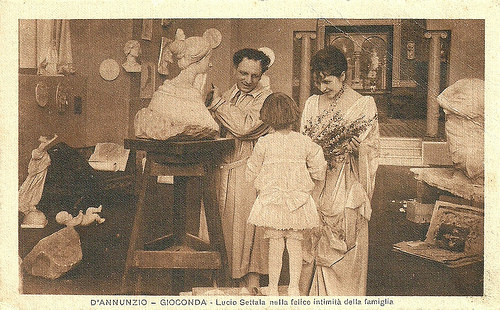
Italian postcard by IPA CT, no. 3654, V. Uff. Rev. St., Terni. Photo: Ambrosio. Caption: 'Lucio Settala in the happy intimacy of the family.' Postcard for the lost Ambrosio production La Gioconda (Eleuterio Rodolfi, 1916, released 1917), based on Gabriele D'Annunzio's play. Umberto Mozzato as Settala and Mercedes Brignone as his wife Silvia.
Famous sculptor Lucio Settala (Umberto Mozzato) lives on the Tuscan coast with Silvia and their daughter Beata. At a Fine Arts exhibition, Lucio encounters the beautiful femme fatale Gioconda Dianti ( Helena Makowska ). She becomes his model for a statue of a female nude in an ecstatic pose.
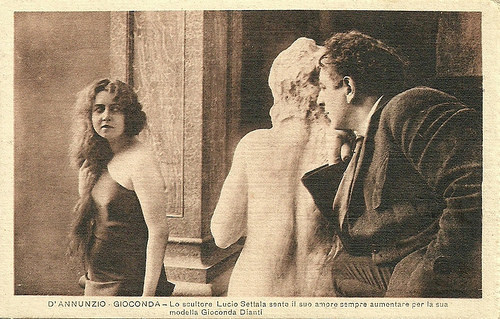
Italian postcard by IPA CT, no. 3877, V. Uff. Rev. St., Terni. Photo: Ambrosio. Caption: 'Sculptor Lucio Settala feels his love for his model Gioconda Dianti is ever expanding.' Umberto Mozzato as Lucio Settala and Helena Makowska as Gioconda Dianti.
More and more, Lucio falls in love with Gioconda and neglects his wife and child. Instead of his angelic wife (Brignone), keeper of family values, he prefers his seductive mistress, the inspiration to his art. His wife suffers in silence.
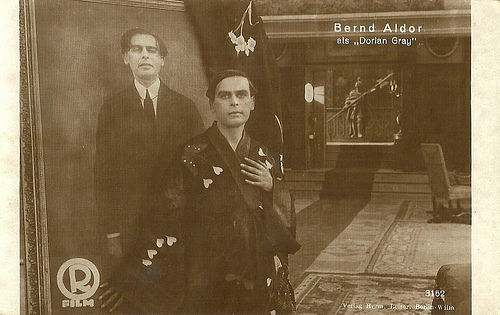
German postcard by Hermann Leiser Verlag, Berlin, no. 3152. Photo: Richard-Oswald-Produktion. Bernd Aldor in Das Bildnis des Dorian Gray (Richard Oswald, 1917), an early German adaptation of Oscar Wilde's famous novel The Picture of Dorian Gray.
Dorian Gray is the subject of a full-length portrait in oil by Basil Hallward. Understanding that his beauty will fade, the hedonistic Dorian expresses the desire to sell his soul, to ensure that the picture, rather than he, will age and fade. The wish is granted, and Dorian pursues a libertine life of varied and amoral experiences, while staying young and beautiful; all the while his portrait ages and records every soul-corrupting sin.
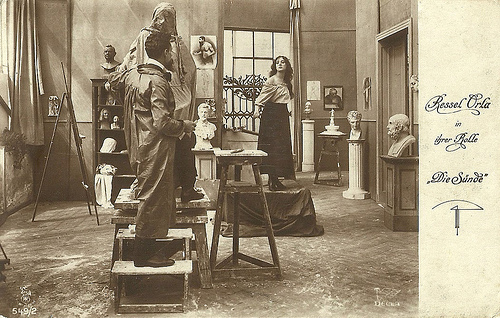
German postcard by Rotphot in the Film Sterne series, no. 549/2. Photo: Decla. Ressel Orla in Die Sünde/The Sin (Alwin Neuss, 1917).
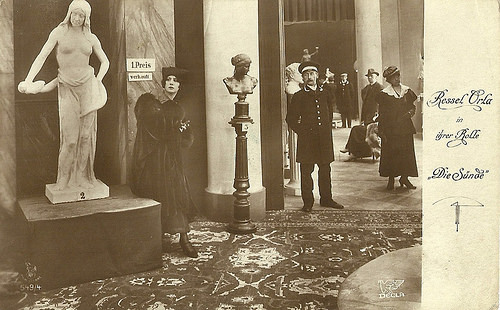
German postcard by Rotphot in the Film Sterne series, no. 549/4. Photo: Decla. Ressel Orla in Die Sünde/The Sin (Alwin Neuss, 1917).

German postcard by Rotophot in the Film Sterne series, no. 516/2. May Film. Photo: May. Mia May and Bruno Kastner in the German silent film Ein Lichtstrahl im Dunkel/A Ray of Light in the Dark (Joe May, 1917).
Count Gerd Palm (Kastner) is known for his flattering portraits of his models, so countess Lydia von Grabor (May), who has a hideous nose, asks him to paint her. Gerd sees through her facade and paints her as a lovely mother. He is so enchanted by a song from her that he asks her marry him. Lydia cannot believe him, so he flees. Years pass, the counts has her nose operated, and returns to Gerd, but discovers he has become blind. Dressed as a nurse she takes care of him. Her care makes him retake his work. He hears she is now ready to marry him, but when he still doubts she sings the song she once sang for him and they finally unite.
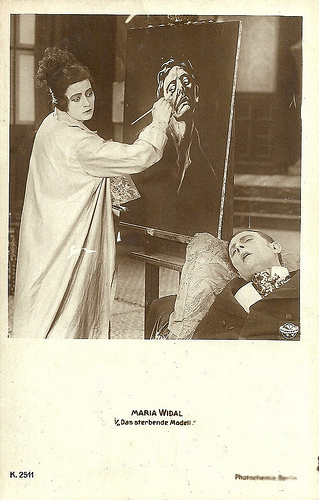
German postcard by Photochemie, no. K2511. Photo: Saturn-Film. Maria Widal in Das sterbende Modell/The dying model (Urban Gad, 1918).
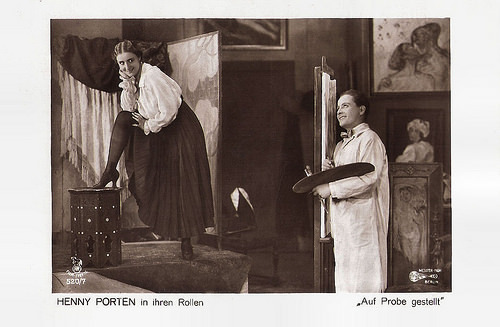
German postcard in the Film Sterne series by Rotophot, no. 520/7. Photo: Messter Film, Berlin. Henny Porten and Hermann Thimig in Auf Probe gestellt/Put to the test (Rudolf Biebrach, 1918).
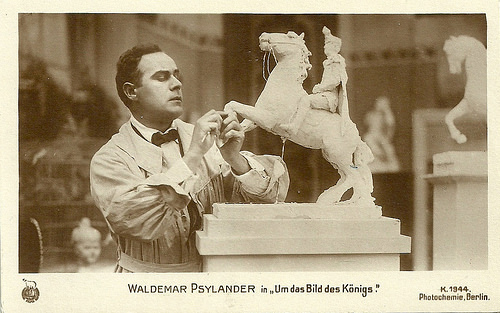
German postcard by Photochemie, Berlin, K. 1944. Photo: Nordisk Films. Valdemar Psilander in Rytterstatuen (A.W. Sandberg, 1919). The German title is Um das Bild des Königs (For the king's statue).
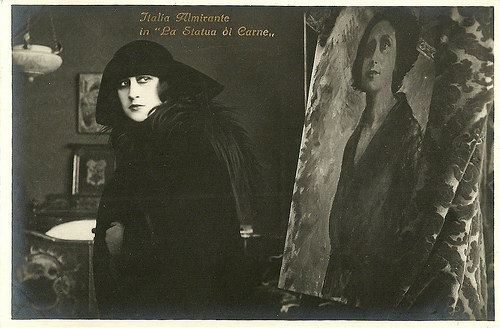
Italian postcard by Fotominio, no. 52. Photo: G.B. Falci, Milano. Italia Almirante in La statua di carne (Mario Almirante 1921). Noemi Keller (Almirante) notices the painted portrait of her lookalike Maria, who has died and whom the painter, count Paolo, is still loving, through Noemi.

Italian postcard by La Fotominio / Ed. G.B. Falci, Milano, no. 115. Photo: Caesar Film. Francesca Bertini and Angelo Ferrari in the Henry Bataille adaptation La donna nuda (Roberto Roberti, 1922).
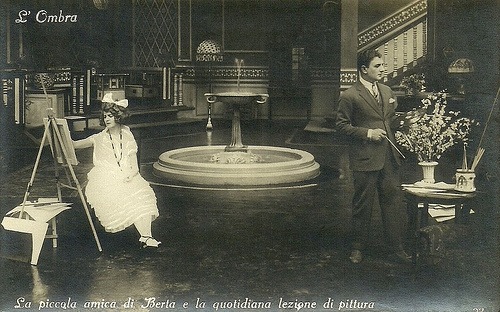
Italian postcard by Ed. Ballerini & Fratini, Firenze. Photo: Alba Film. Publicity still for L'ombra (Mario Almirante, 1923), starring Italian diva Italia Almirante as Berta, Liliana Ardea as Elena (left) and Alberto Collo as Berta's husband Gerardo (right). Caption: 'Berta's little friend and the daily painting lesson.'
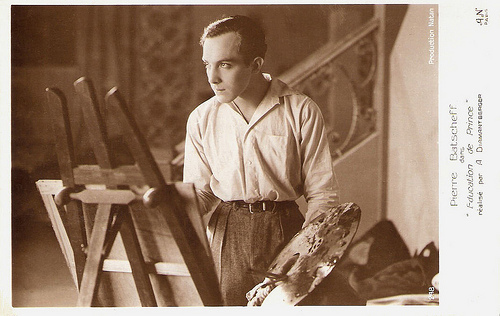
An extra postcard. French postcard by A.N. Paris, no. 248. Photo: Production Natan. Publicity still of Pierre Batcheff in Education de prince (Henri Diamant-Berger, 1927).
This is a post for Postcard Friendship Friday, hosted by Beth at the The Best Hearts are Crunchy. You can visit her by clicking on the button below.


Italian postcard by IPA CT, no. 3654, V. Uff. Rev. St., Terni. Photo: Ambrosio. Caption: 'Lucio Settala in the happy intimacy of the family.' Postcard for the lost Ambrosio production La Gioconda (Eleuterio Rodolfi, 1916, released 1917), based on Gabriele D'Annunzio's play. Umberto Mozzato as Settala and Mercedes Brignone as his wife Silvia.
Famous sculptor Lucio Settala (Umberto Mozzato) lives on the Tuscan coast with Silvia and their daughter Beata. At a Fine Arts exhibition, Lucio encounters the beautiful femme fatale Gioconda Dianti ( Helena Makowska ). She becomes his model for a statue of a female nude in an ecstatic pose.

Italian postcard by IPA CT, no. 3877, V. Uff. Rev. St., Terni. Photo: Ambrosio. Caption: 'Sculptor Lucio Settala feels his love for his model Gioconda Dianti is ever expanding.' Umberto Mozzato as Lucio Settala and Helena Makowska as Gioconda Dianti.
More and more, Lucio falls in love with Gioconda and neglects his wife and child. Instead of his angelic wife (Brignone), keeper of family values, he prefers his seductive mistress, the inspiration to his art. His wife suffers in silence.

German postcard by Hermann Leiser Verlag, Berlin, no. 3152. Photo: Richard-Oswald-Produktion. Bernd Aldor in Das Bildnis des Dorian Gray (Richard Oswald, 1917), an early German adaptation of Oscar Wilde's famous novel The Picture of Dorian Gray.
Dorian Gray is the subject of a full-length portrait in oil by Basil Hallward. Understanding that his beauty will fade, the hedonistic Dorian expresses the desire to sell his soul, to ensure that the picture, rather than he, will age and fade. The wish is granted, and Dorian pursues a libertine life of varied and amoral experiences, while staying young and beautiful; all the while his portrait ages and records every soul-corrupting sin.

German postcard by Rotphot in the Film Sterne series, no. 549/2. Photo: Decla. Ressel Orla in Die Sünde/The Sin (Alwin Neuss, 1917).

German postcard by Rotphot in the Film Sterne series, no. 549/4. Photo: Decla. Ressel Orla in Die Sünde/The Sin (Alwin Neuss, 1917).

German postcard by Rotophot in the Film Sterne series, no. 516/2. May Film. Photo: May. Mia May and Bruno Kastner in the German silent film Ein Lichtstrahl im Dunkel/A Ray of Light in the Dark (Joe May, 1917).
Count Gerd Palm (Kastner) is known for his flattering portraits of his models, so countess Lydia von Grabor (May), who has a hideous nose, asks him to paint her. Gerd sees through her facade and paints her as a lovely mother. He is so enchanted by a song from her that he asks her marry him. Lydia cannot believe him, so he flees. Years pass, the counts has her nose operated, and returns to Gerd, but discovers he has become blind. Dressed as a nurse she takes care of him. Her care makes him retake his work. He hears she is now ready to marry him, but when he still doubts she sings the song she once sang for him and they finally unite.

German postcard by Photochemie, no. K2511. Photo: Saturn-Film. Maria Widal in Das sterbende Modell/The dying model (Urban Gad, 1918).

German postcard in the Film Sterne series by Rotophot, no. 520/7. Photo: Messter Film, Berlin. Henny Porten and Hermann Thimig in Auf Probe gestellt/Put to the test (Rudolf Biebrach, 1918).

German postcard by Photochemie, Berlin, K. 1944. Photo: Nordisk Films. Valdemar Psilander in Rytterstatuen (A.W. Sandberg, 1919). The German title is Um das Bild des Königs (For the king's statue).

Italian postcard by Fotominio, no. 52. Photo: G.B. Falci, Milano. Italia Almirante in La statua di carne (Mario Almirante 1921). Noemi Keller (Almirante) notices the painted portrait of her lookalike Maria, who has died and whom the painter, count Paolo, is still loving, through Noemi.

Italian postcard by La Fotominio / Ed. G.B. Falci, Milano, no. 115. Photo: Caesar Film. Francesca Bertini and Angelo Ferrari in the Henry Bataille adaptation La donna nuda (Roberto Roberti, 1922).

Italian postcard by Ed. Ballerini & Fratini, Firenze. Photo: Alba Film. Publicity still for L'ombra (Mario Almirante, 1923), starring Italian diva Italia Almirante as Berta, Liliana Ardea as Elena (left) and Alberto Collo as Berta's husband Gerardo (right). Caption: 'Berta's little friend and the daily painting lesson.'

An extra postcard. French postcard by A.N. Paris, no. 248. Photo: Production Natan. Publicity still of Pierre Batcheff in Education de prince (Henri Diamant-Berger, 1927).
This is a post for Postcard Friendship Friday, hosted by Beth at the The Best Hearts are Crunchy. You can visit her by clicking on the button below.

Published on March 03, 2016 22:00
Paul van Yperen's Blog
- Paul van Yperen's profile
- 13 followers
Paul van Yperen isn't a Goodreads Author
(yet),
but they
do have a blog,
so here are some recent posts imported from
their feed.



